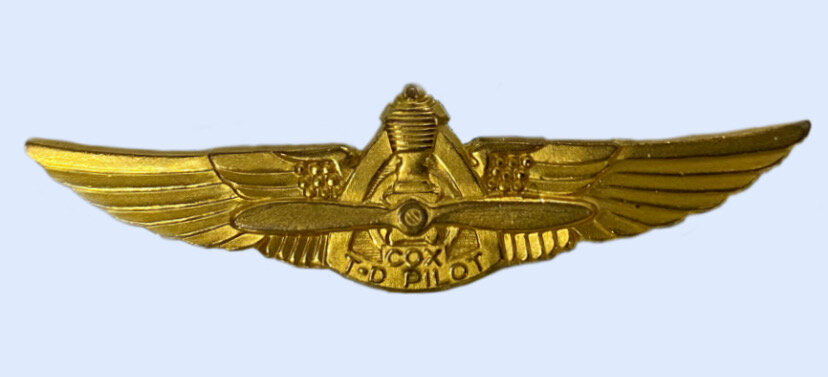FLIGHT CIRCLE (WEN•MAC & COX THIMBLE DROME FLIGHT CIRCLE)
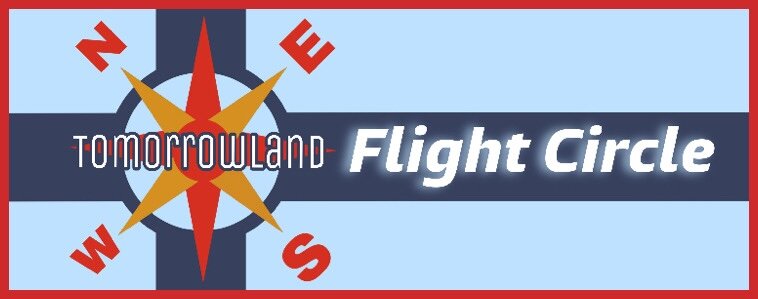
(September, 1955 - January, 1966)
The popularity of model airplanes was on the rise during the 1950s - so much that they were featured on a recurring segment of the Mickey Mouse Club during the first season. The mini-series “What I Want To Be” (a segment geared toward encouraging aspiring stewardesses and pilots) focusing heavily on inspiration from local model aircraft clubs. Soon, the sport would find a place within Walt Disney’s developing Disneyland.
By July 1, 1954, George Whitney of Disneyland, Inc. directed Amusements, with Ron Miller overseeing analysis, philosophy, capacities, planning, operator training, and amusement procurement. Some of Marvin Davis’ site plans of Tomorrowland included an area detailed as an “airplane exhibit.”
During 1954, Walt was searching for participants to lease exhibit, shop, and restaurant spaces at Disneyland® Park, and help generate the necessary capital to fund construction of Disneyland. By July 1, 1954, Russel Tippett of Disneyland Inc. Advertising oversaw Exhibitor’s Space Sales and Lease Agreements. So, in a synergistic relationship, the companies would absorb operations costs in exchange for the opportunity to sell their products and advertise their corporate names in the Park - and the Tomorrowland Flight Circle was created.
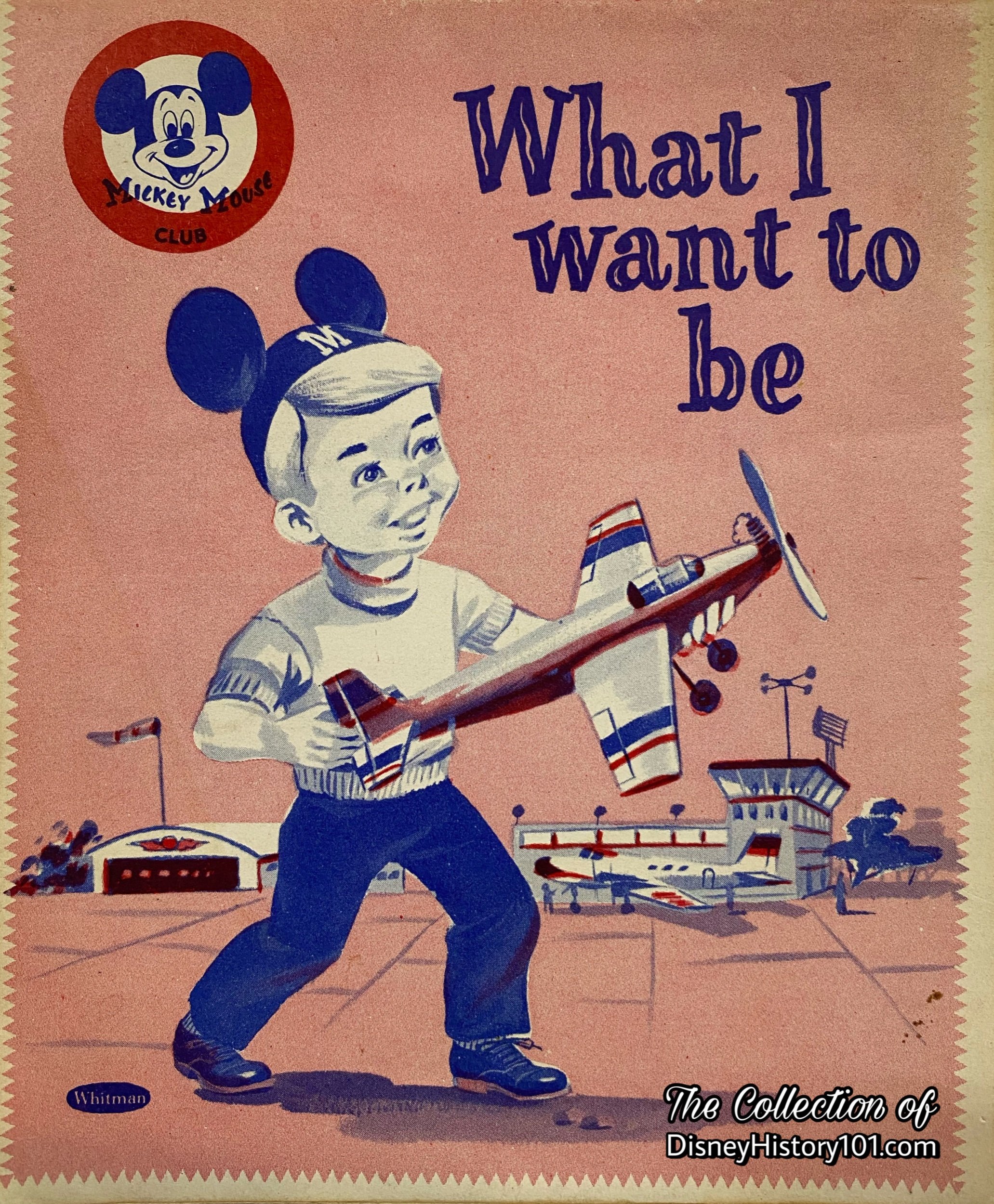
“What I want to Be” activity books and segments of the Mickey Mouse Club encouraged aspiring pilots and stewardesses.
Soon, aerial shows would have a place at Disneyland since the moment that 80 jet planes soared over the Park during the televised Opening Day Ceremonies! For almost a decade thereafter, the presentation of the Tomorrowland Flight Circle (or “Model Aircraft Flight Circle”) show on the vast DISNEYLAND “stage” was a distinct part of the Disneyland theater concept.
The Flight Circle continued the tradition of airshows at Disneyland, providing free daily shows that became one of Tomorrowland’s premier attractions!
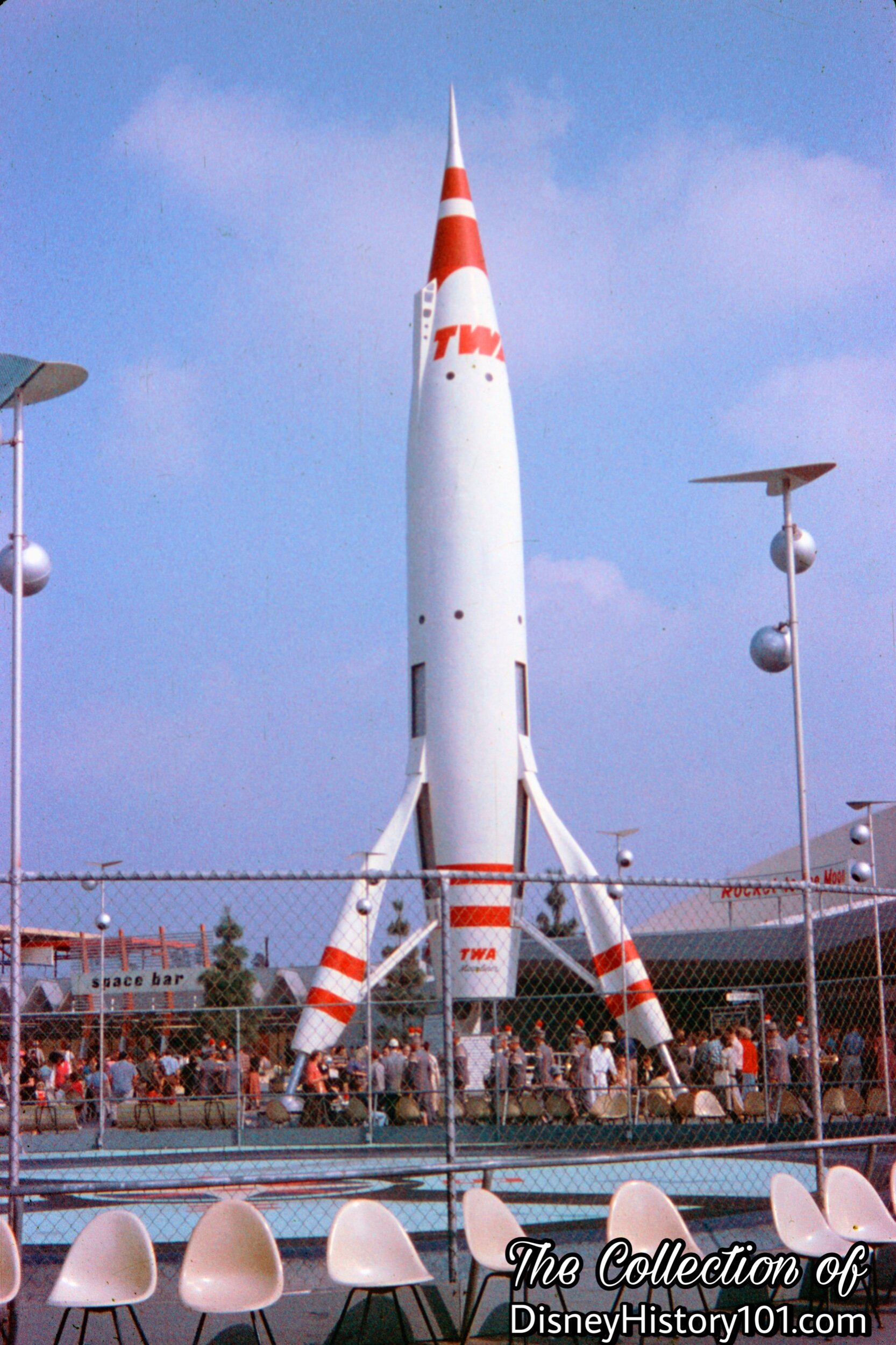
Flight Circle, 1955
During September of 1955, a concrete floor, concrete curbing, and a water pond was constructed in Tomorrowland. Next, a 12-foot fence was erected around the entire 3,846 square-foot Flight Circle setting the stage for an exciting new show that was soon to land in Tomorrowland!
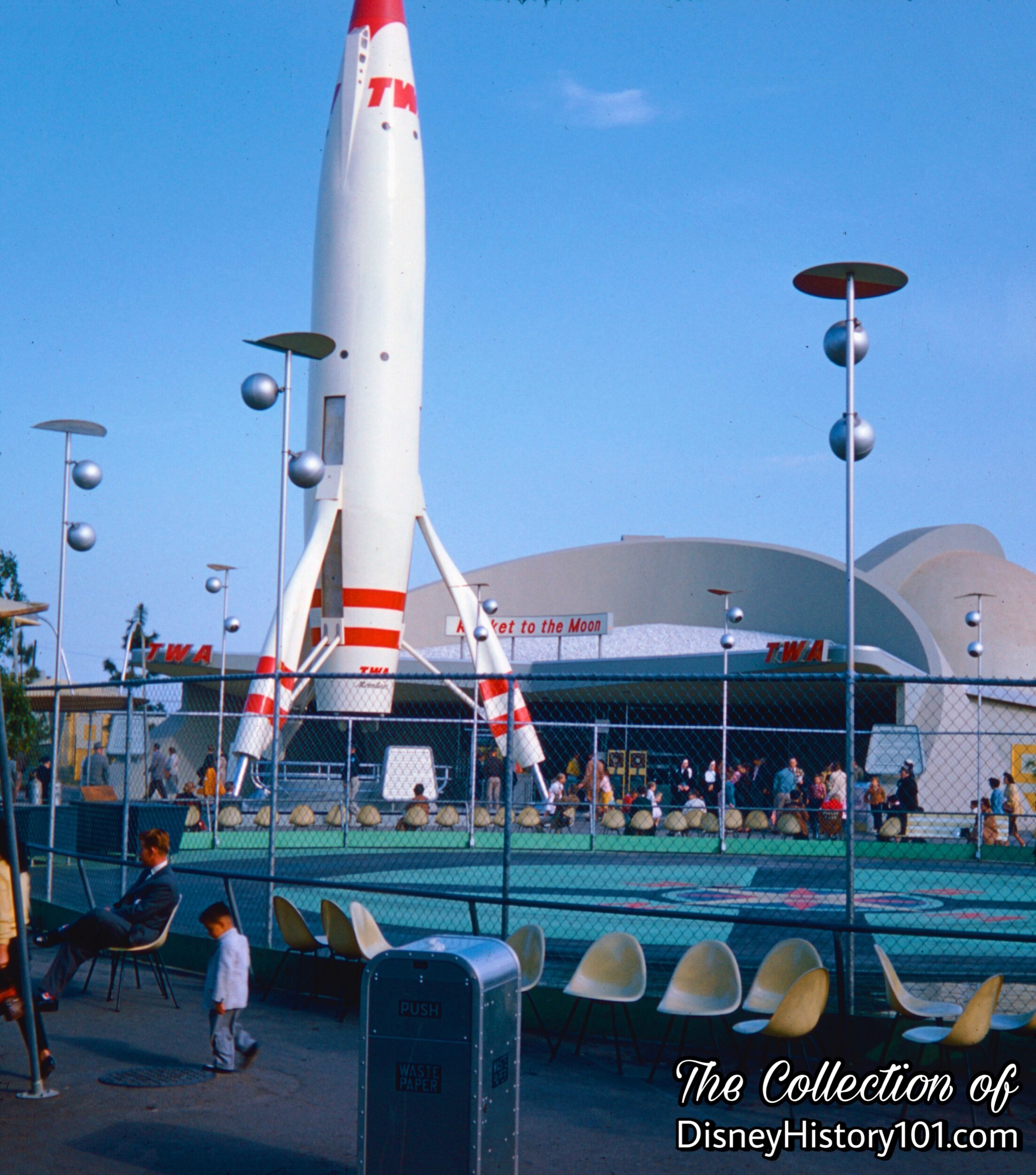
Flight Circle or "Hobbyland"
The Flight Circle with its compass rose (in the foreground) was located near an area called “Hobbyland.”

Flight Circle (left) and "Hobbyland" (right).
Hobbyland was situated at the hub of Tomorrowland, operating from September 4, 1955 to 1966. During this era, many merchandise locations offered General Merchandise - non-character and/or decorative items, including film and sundries. Under the heavy plastic umbrella coverings of Hobbyland were 1,031 square feet of amusing souvenir crafts (a Disneyland Inc. asset appraised between $5,350-$5,400). The operation of the Souvenir Stands and merchandise sales came under the oversight of Jim Baker of Disneyland, Inc.
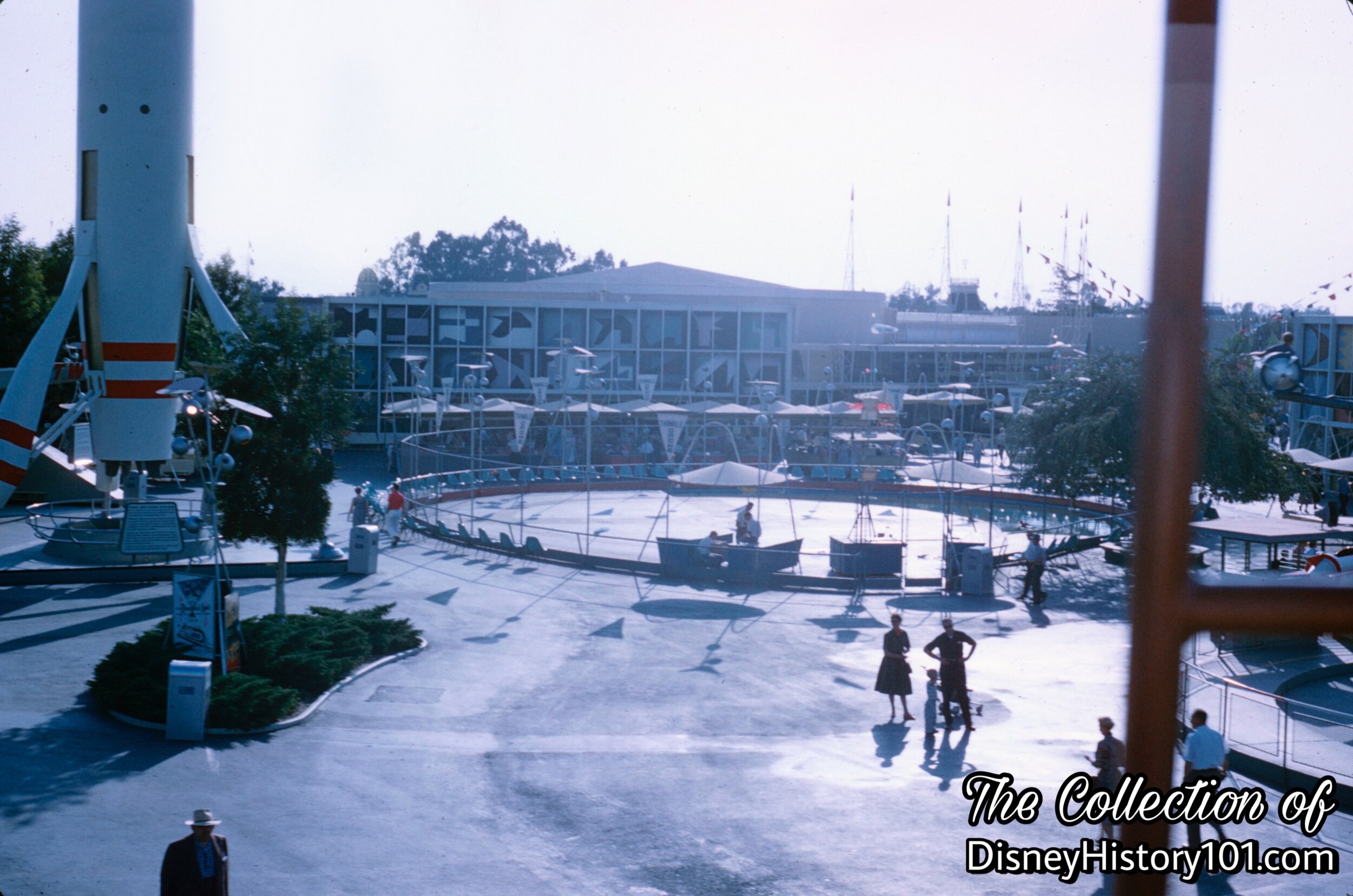
Flight Circle
Just beyond the Flight Circle were other flight-based attractions (like the AstroJets and TWA Flight to the Moon). One neighboring hall hosted the Tomorrowland Art Corner, where guests found an abundance of arts and crafts (including models) for purchase. However, the Flight Circle was the only free flight-based show of its kind in the Park.
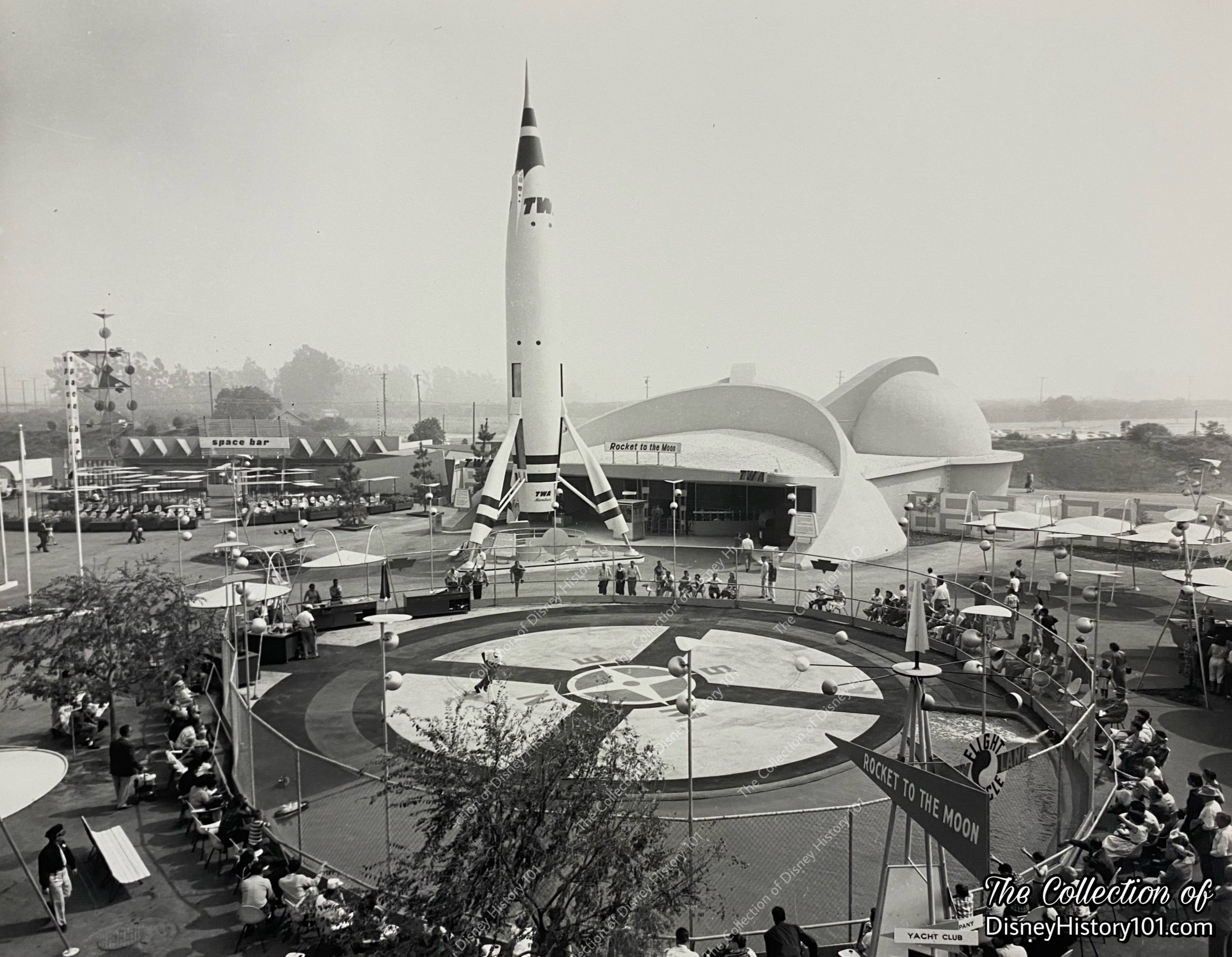
Tomorrowland Flight Circle, ©️Walt Disney Productions.
Please, step this way as we now explore the Flight Circle’s two sponsorship eras. In the earliest days of the Flight Circle, the first sponsor was Wen-Mac.

Wen-Mac Flight Circle (September, 1955 - January, 1958)
“Welcome to the Disneyland Flight Circle Show presented by the Wen-Mac Corporation, world’s largest producer of action toys!” - Flight Circle Announcer, 1958.
Every hour, audiences would hear those words of the spiel spoken by Attractions Hostess Bonnie Purdy [yes, a c.1958 female Flight Circle Announcer]: “Welcome to the Disneyland Flight Circle Show presented by Wen-Mac Corporation, world’s largest producer of action toys.” You may recall seeing Wen-Mac’s line of battery-operated, motorized, giant connection “action toys” on display and in action!

A WEN-MAC Disneyland Giant Action Toys box graphic.
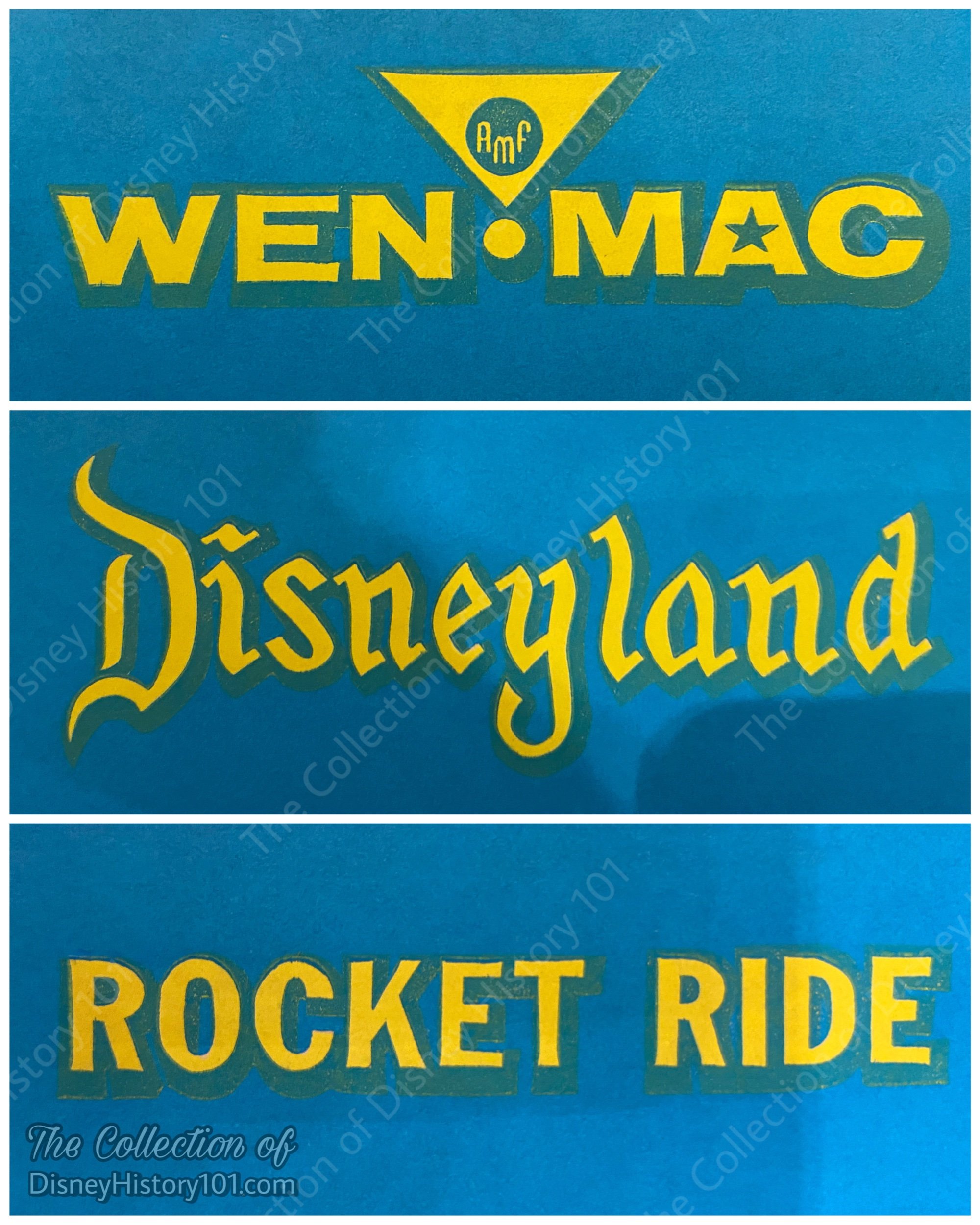
A WEN-MAC Disneyland Rocket Ride box graphic.
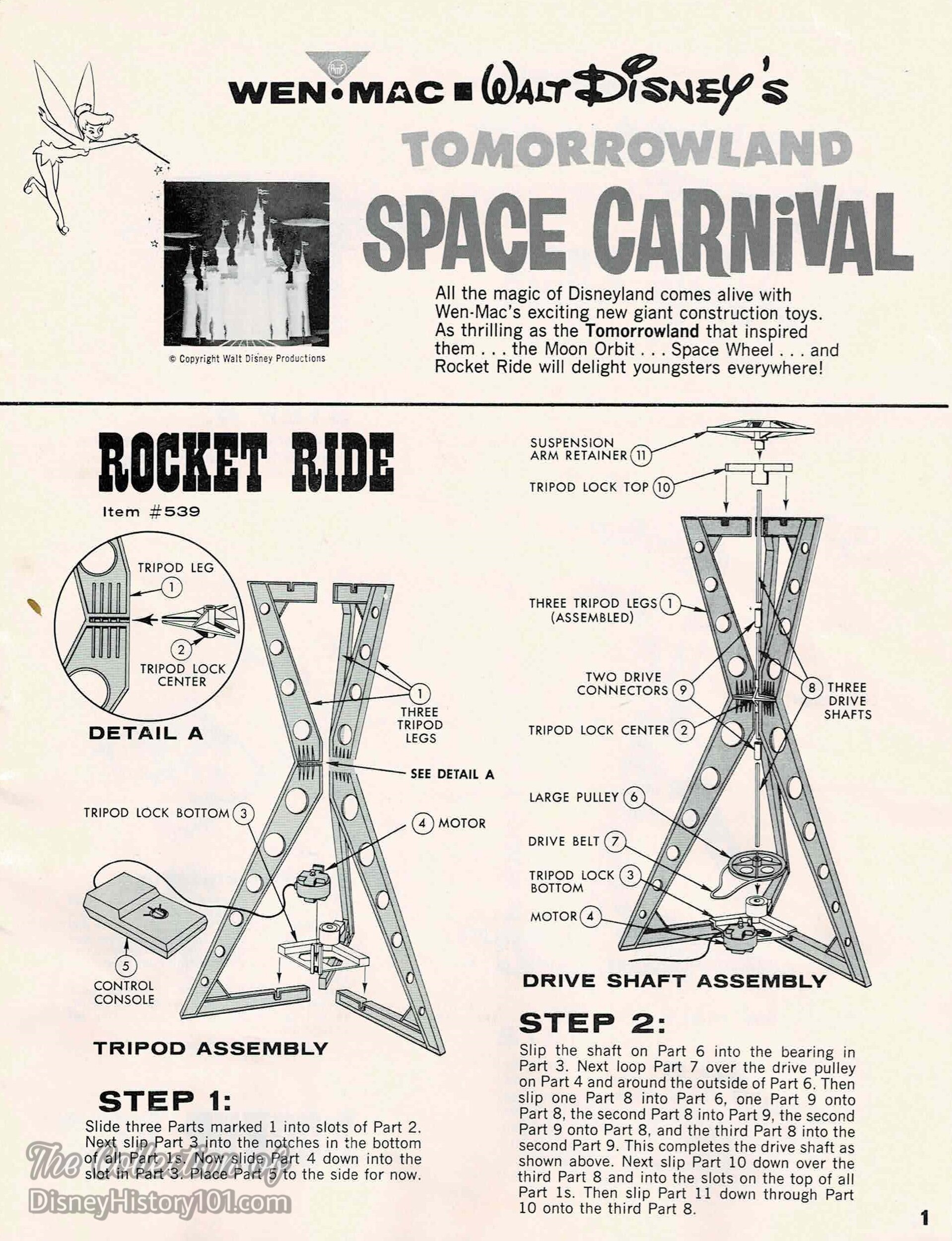
WEN•MAC "Space Carnival" Instructions
Several models of these boxed “giant construction toys” were part of the “Walt Disney’s Tomorrowland Space Carnival” line manufactured by the Wen-Mac Corporation (a subsidiary of American Machine & Foundry Company). All of these toys were “as thrilling as the Tomorrowland that inspired them… the Moon Orbit [Item #537]…Space Wheel [Item #535]…and the Rocket Ride [Item #539]” were offered and sure to “delight youngsters everywhere.”
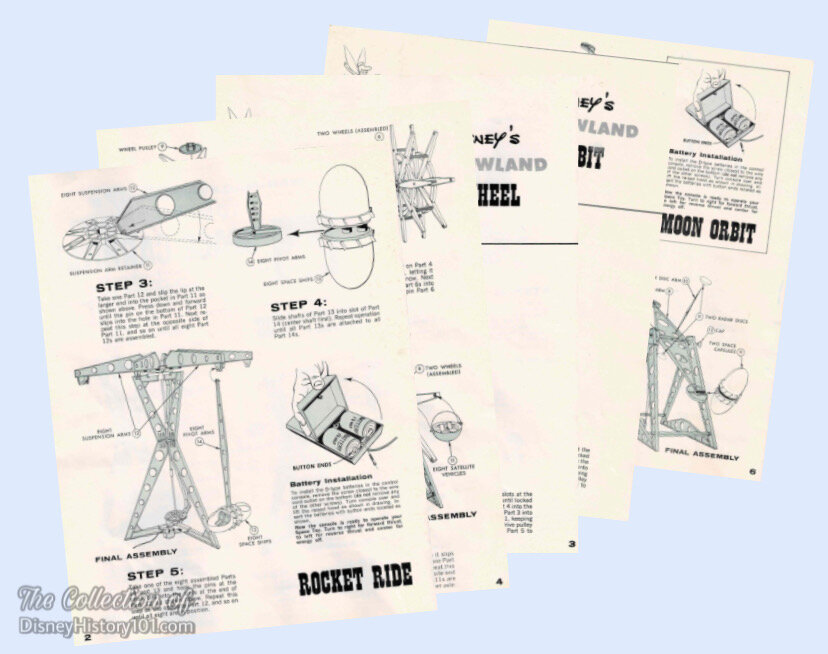
WEN•MAC "Space Carnival" Instructions
In addition to these mechanized construction toys, Wen-Mac was currently manufacturing “‘ready-to-fly’ all-plastic planes,” which were started by the pull of an automatic recoil cable. In an era of light-weight balsa wood model planes, Wen-Mac airplanes were described as “perfectly engineered…a plane easy to fuel and fly without any of the tedious and painstaking construction work necessary in the past.” According to Disneylander (January, 1958), “The McRoskey’s, Len and Jack, began their fabulous climb to becoming the world’s largest aircraft manufacturer.”
By this time, Wen-mac’s plastic models (with miniature fuselages and wings), were powered by a real internal combustion engine (housing a piston, spark plug, crank shaft, and connecting rod). The little engines turned an amazing 18,500 rpms (revolutions per minute) - that’s 308 revolutions-per-second! In addition, some of their 1950s models could amazingly drop bombs, fire rockets, and even eject parachutes while in flight. Some of these amazing features were demonstrated within Disneyland’s Flight Circle, by seasoned aviation enthusiasts and hobby specialists!
“And Now, I Want To Introduce Our Flight Crew…”
By October of 1955, Wen Mac models were beginning to be a household name, and popular hobbies among aviation fans of all ages! Operators can be seen flying the model planes on the Walt Disney Studio Burbank lot, performing combat maneuvers and even attempting to land them on the deck of a model recreation of the U.S.S. Forrestal supercarrier, during the “What I Want To Be” segment of the Mickey Mouse Club anthology television series (season 1 ; episode 2). Over at Disneyland (that very month of October of 1955), the daily show was operated by Bud Hartranft (a former Army Air Forces, TWA, American, and KLM airlines pilot), Chuck Coryell (a former railroad signal man), and Dennis Schauer - all donned in boots and plastic safety caps. The trio would demonstrate commercial models that could be purchased in kits, as well as special one-of-a-kind models built by the hobbyists.
Two months later (during the winter holiday season, on December 1, 1955) and in conjunction with the Flight Circle, some of the first “Model Clubs” met in Tomorrowland (and other areas around Disneyland). A year later, several scenes of “Disneyland U.S.A.” (released by Buena Vista Film Distribution, December 20, 1956) preserved moving images of this occasion and “special area reserved for model airplane clubs.” Something that needs to be seen to be believed, occurred during the second meeting of “Model Clubs” at Disneyland - visitors operating small-scale model boats in Swan Lake (near Sleeping Beauty Castle) and even navigating their miniature craft through the Jungle Rivers of the World. Fortunately, some brief footage of this activity was also captured and preserved in “Disneyland - The Park,” a short-film party of the Disneyland anthology television series (first aired 1957).
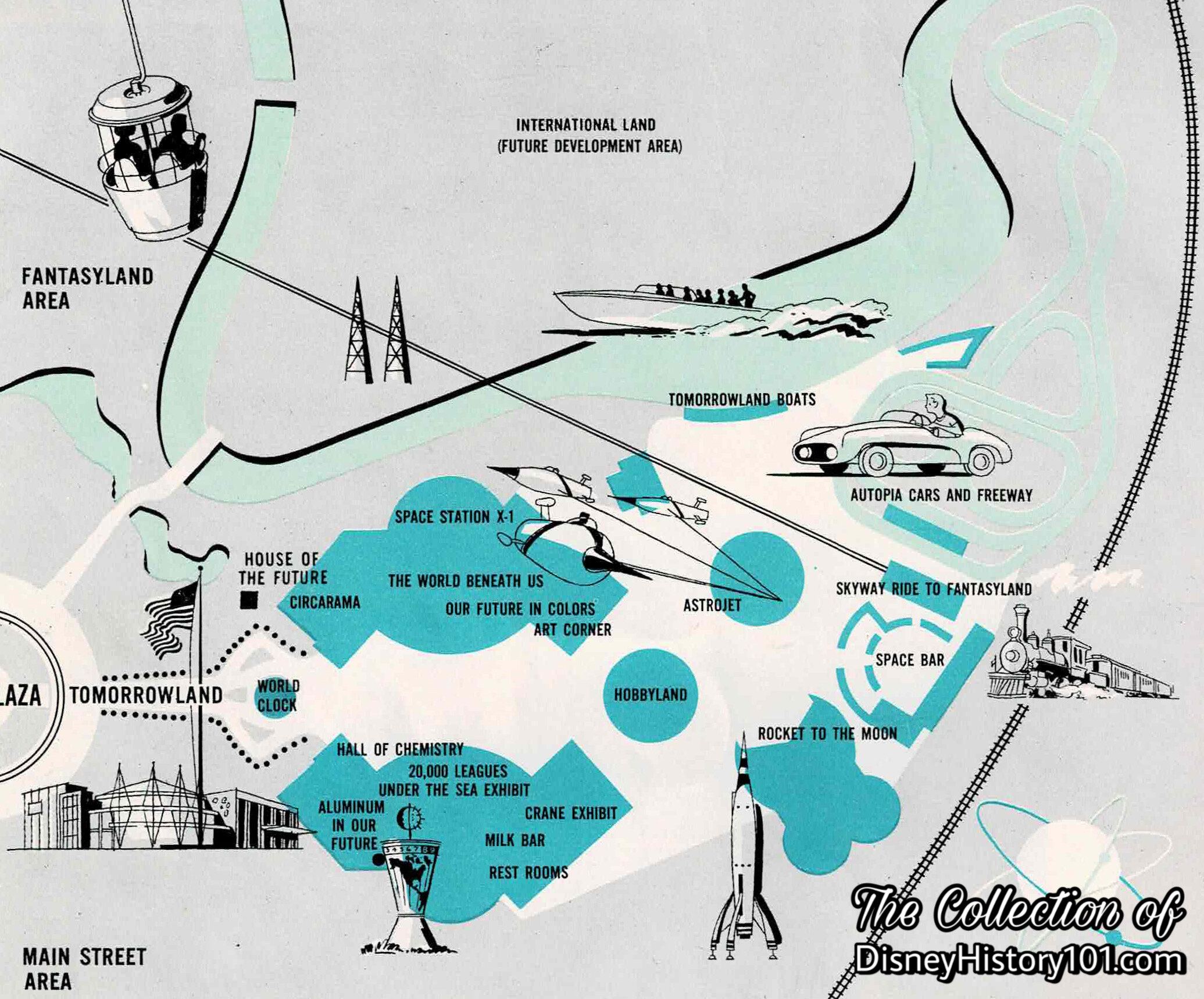
Hobbyland featured in "A Complete Guide To Disneyland", 1957.
“Hobbyland”
It seems that shows ceased, for at least a period of 1957. Copies of “A Complete Guide To Disneyland” (published 1957) label the area as “Hobbyland” (see map excerpt above;“The Complete Guide To Disneyland”, published 1957), but there is no mention of it among the list of “Exhibits” or “Shows” in Tomorrowland. In addition, the only photo of the Flight Circle to be featured in the Guide is devoid of Operators or model craft. Hobbyland was still a place where Guests could purchase model cars (by Wen-Mac, Matchbox, and other manufacturers), planes & boats.
It may have been at this time (during November of 1957) that television’s Mouseketeers (like Bobby Burgess, Annette Funicello, Karyn Pendletonan others) made an appearance both performing and singing autographs from the Flight Circle “Stage.”
Not far from Hobbyland (located in this central area of Tomorrowland) Disneyland Guests found other art-related merchandise locations and exhibits. For example, visitors could still have their portrait drawn on the “Streets of Paris” in The Art Corner. The Art of Animation was a great place to purchase Disney ‘originals’ and arts & crafts, and just across the way guests could visit interchanging exhibits and displays like the 20,000 Leagues Exhibit.
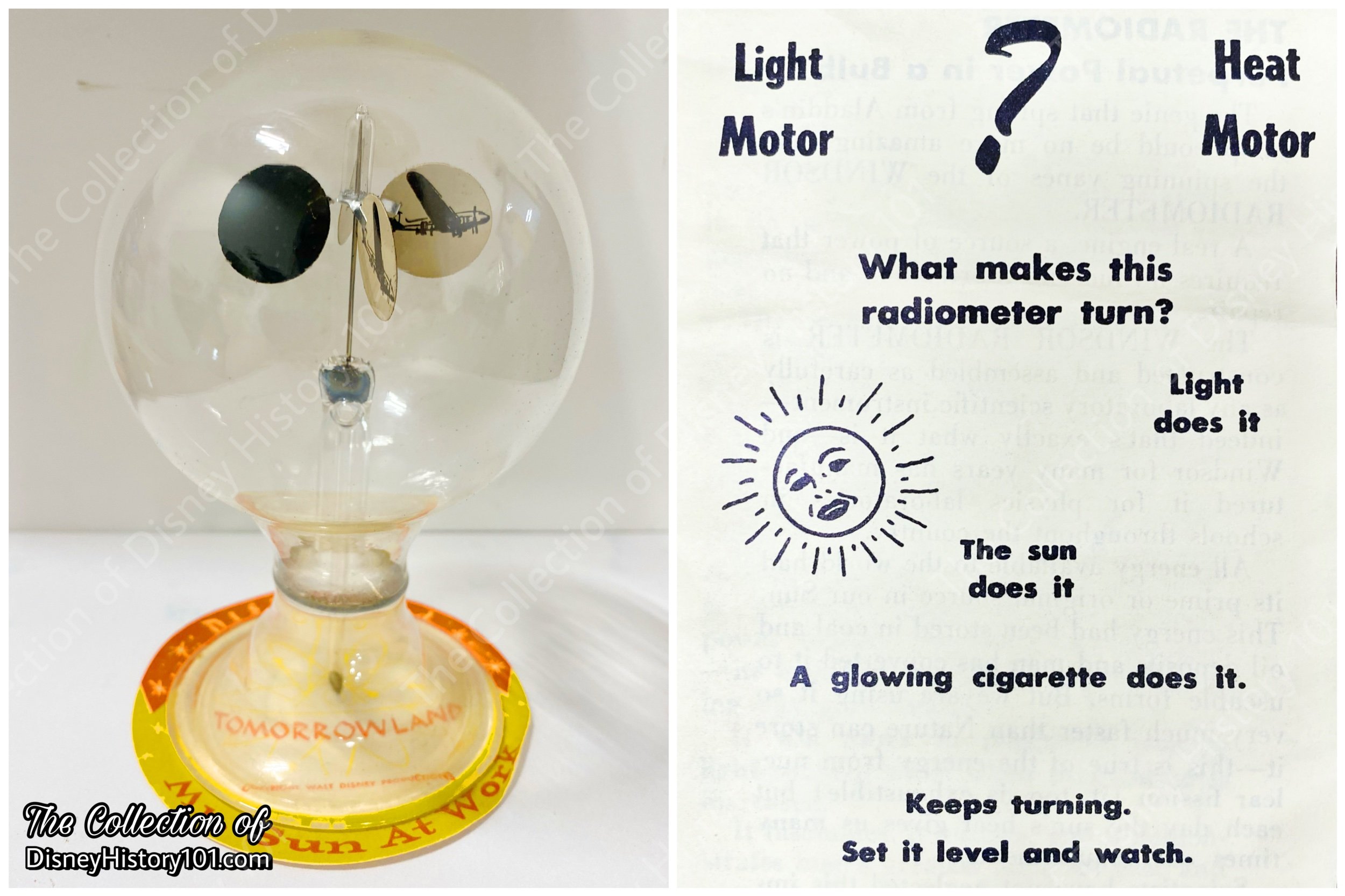
A Disneyland Radiometer toy sold in Hobbyland.
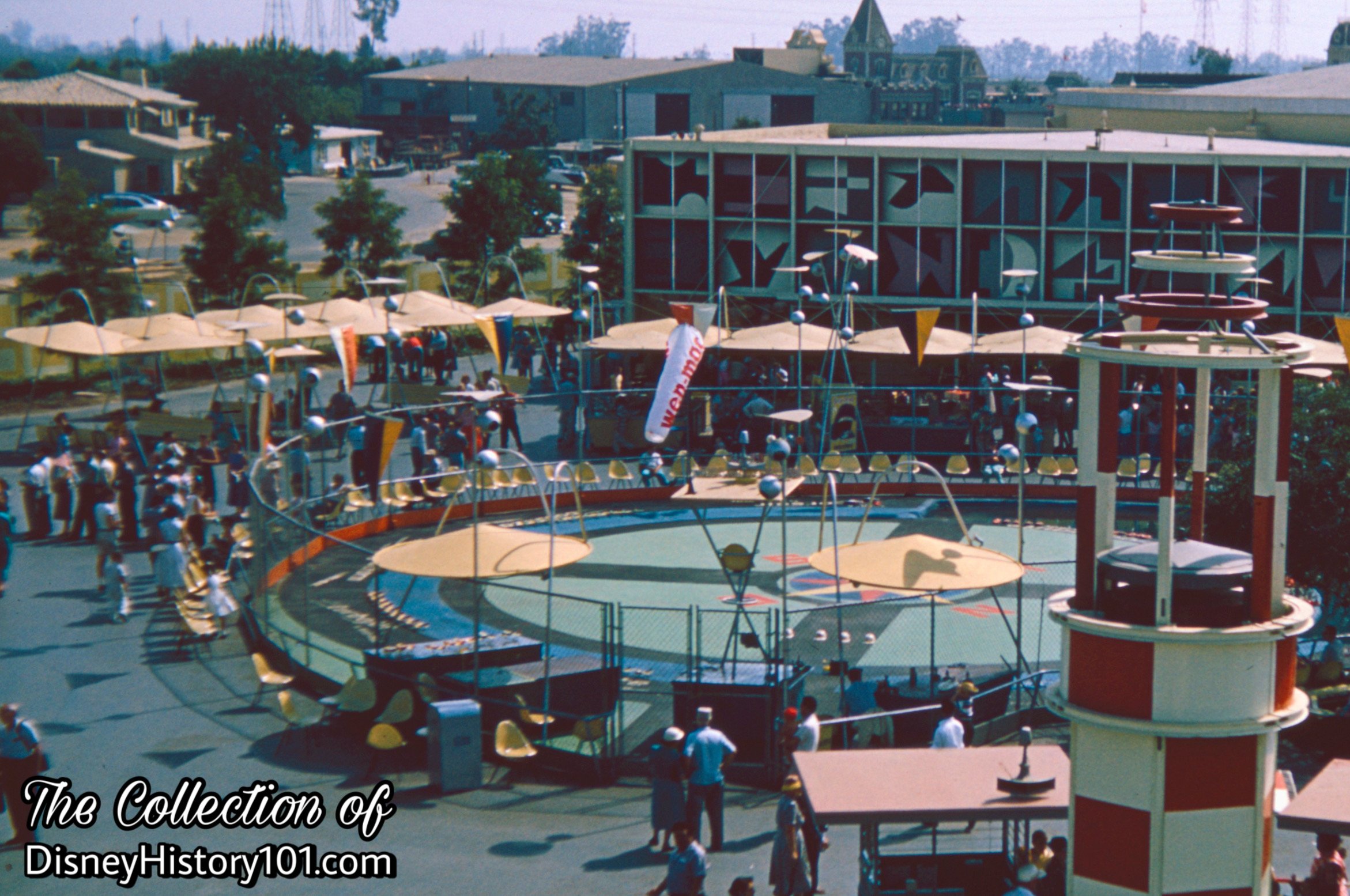
Note the WEN*MAC name on the windsock over the Wen-Mac Flight Circle, first appearing during the summer of 1958.
By 1958, the West Los Angeles-based Wen-Mac Corporation had celebrated its 7th anniversary.
At that time, shows were first performed by pilots of Wen-Mac’s pulse jet-propelled model planes (which ran on alcohol and white gas fuel), propeller-driven race cars, gasoline-powered boats (with real scale outboard motors), and battery-powered radio-controlled tug boats being tested from the seating area just beyond the fence. The 20-minute free shows started hourly from 11 a.m. to 7 p.m., six days a week.
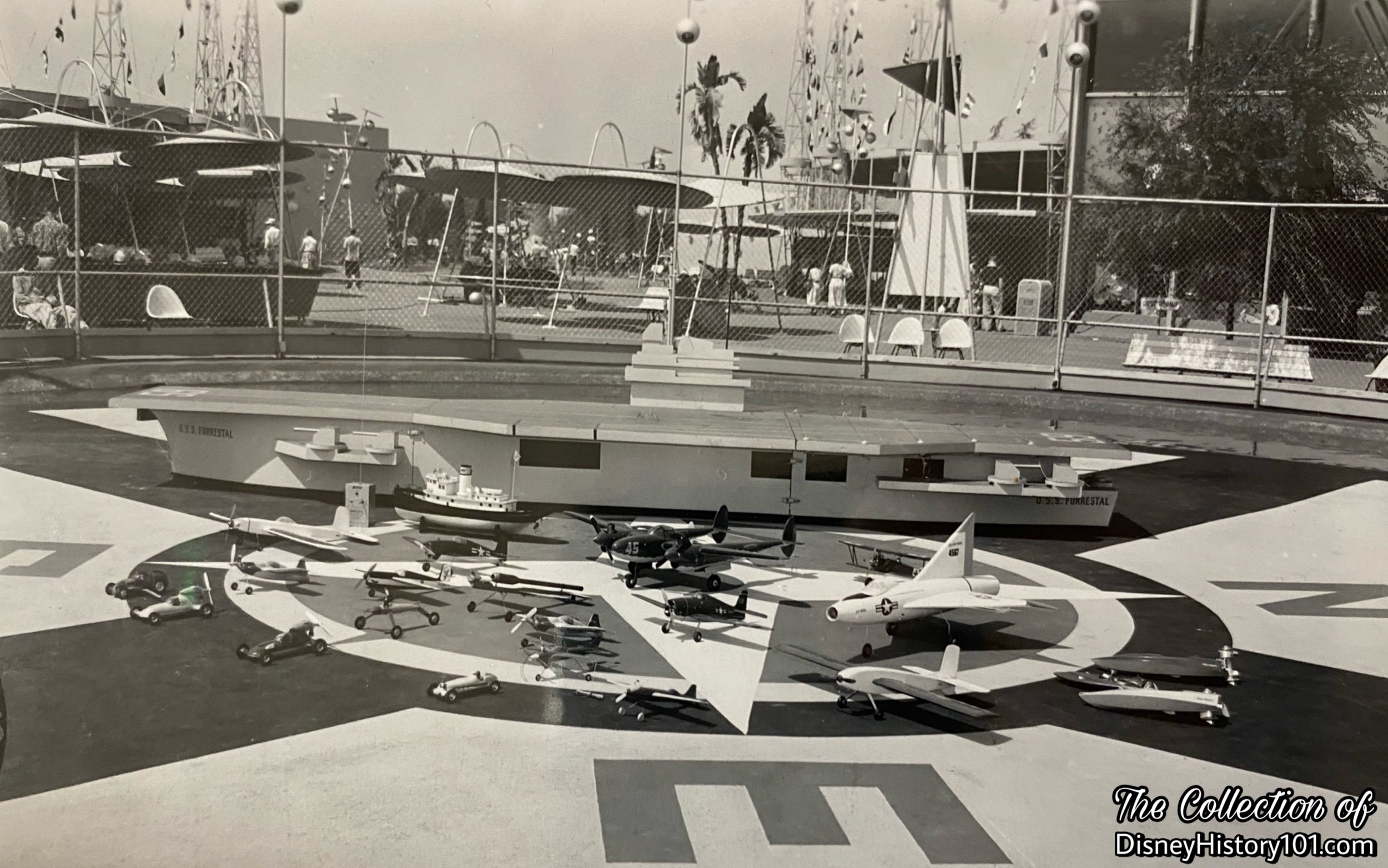
© Walt Disney Company.
The 1957 TWA brochure “Let’s Talk About… My Visit to Disneyland, Anaheim, California: A Note from Mary Gordon TWA Travel Advisor” mentioned: “We learned that to fully explore Disneyland takes two days, so early next morning we were at the gates of the park again. The second day we spent more time shopping in the 50 inviting shops, and the youngsters bought inexpensive souvenirs to take home to friends.”
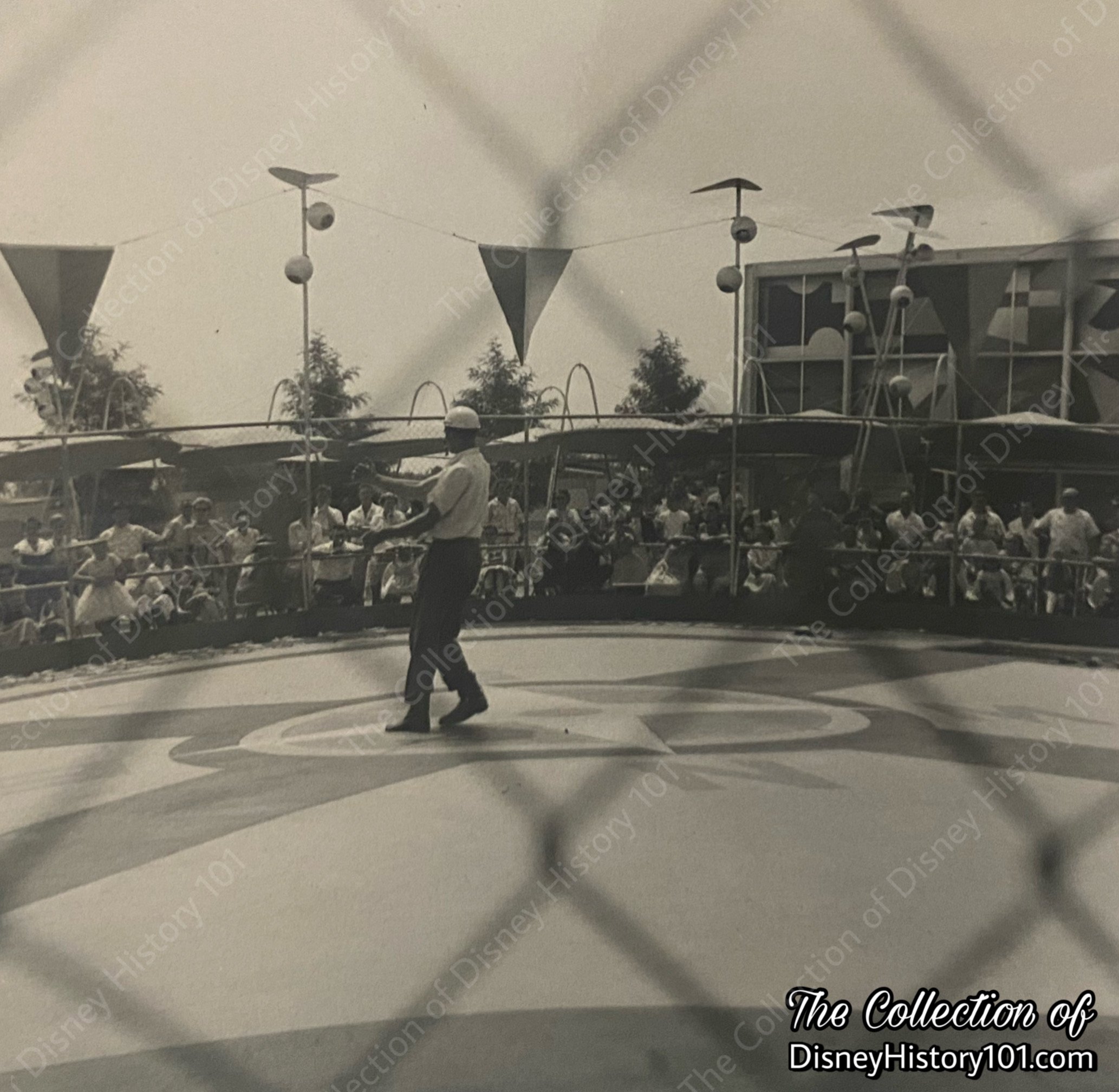
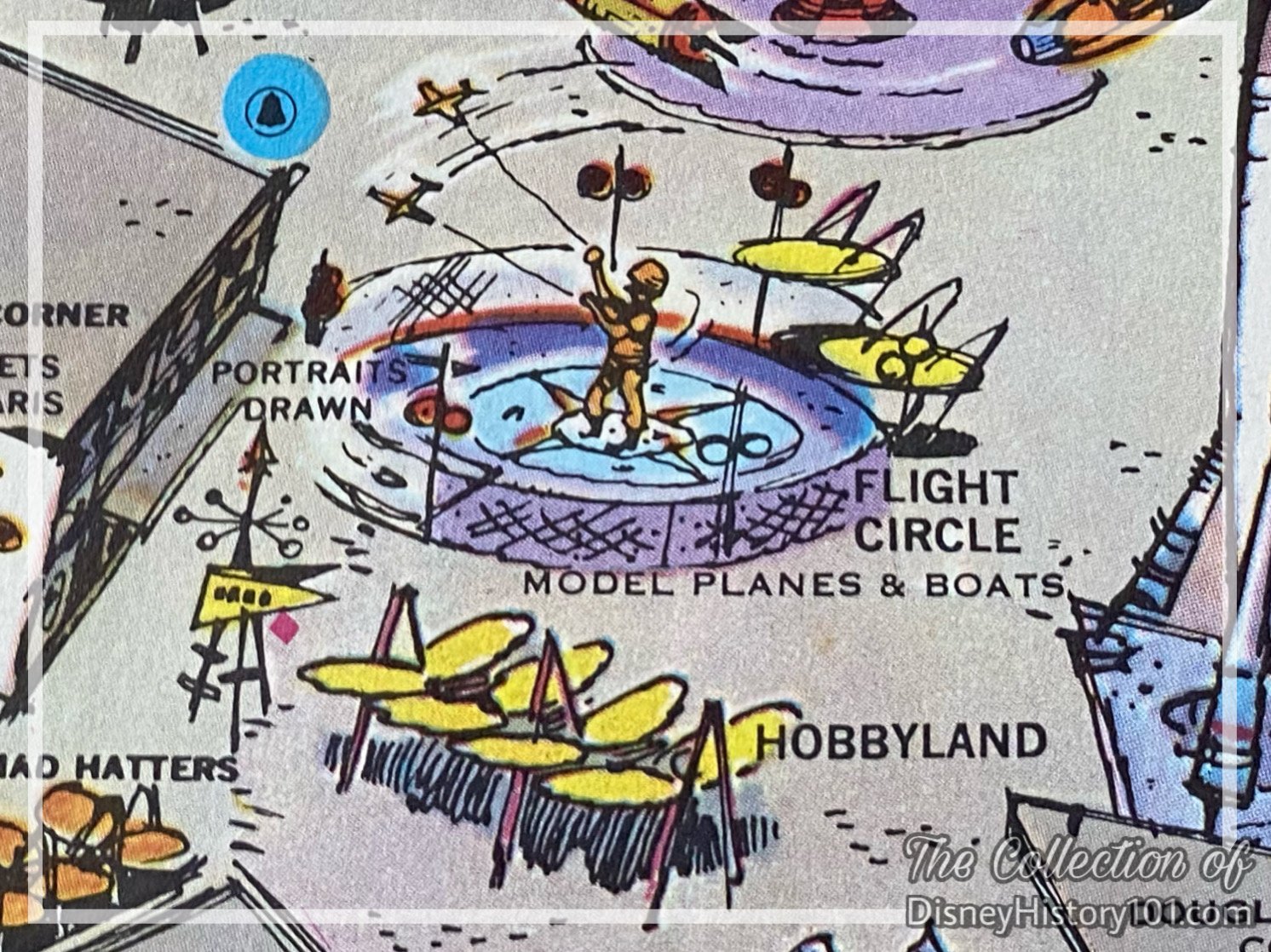
A 1958 Disneyland Fun Map depicting the Atmosphere Entertainment provided by a Flight Circle Attractions Host; © Walt Disney Company.
That very year (of 1958), the Disneyland Flight Crew was headed by Walt Norris. An article published in Disneylander (January, 1958) continues : “‘Big’ Walt is famous for his ‘3 at one time’ stunt with the Wen-Mac planes. He holds one Turbojet plane in each hand and one in his mouth. And, when you see Walt hustling on this event, remember those 3 planes fly 35 miles per hour.” Other supporting Flight Circle Attractions Hosts (of 1958) - Travis Odom, Don Hatcher, and Keith Palmer - “assist Walt in the flying of Flight Circle’s planes and racing of the speedboats, and Don doubles as announcer.” Owing to these talented operators, audiences of the Flight Circle routinely applauded and cheered the amazing aerial, automotive, and nautical stunts!
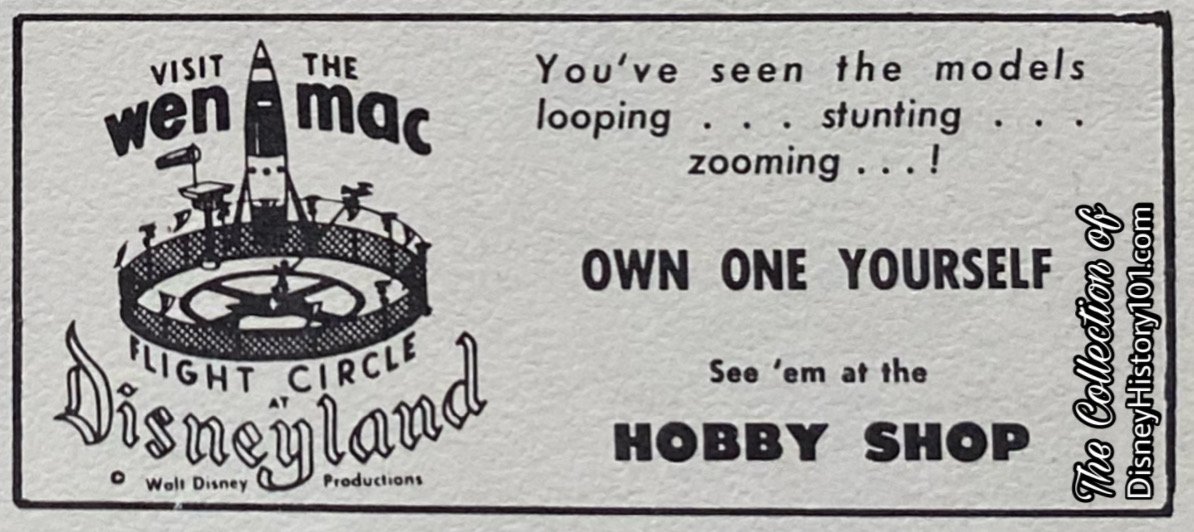
An advertisement in the Merchants Mart section of a c.1958 “Disneylander” alerts employees of discounts.
The synergy was beneficial for Disneyland! Disneyland Inc. received a certain amount of income from WEN•MAC. For example, in 1958, Bank of America appraisers figured of the total income received from leases, 16.02% was derived from the selling of advertising rights and 40.12% from the leasing of space to concerns whose main reason for occupancy is for advertising purposes. The remaining 43.86% of the lease income was derived from merchandise locations (as those near WEN•MAC Flight Circle) which sold various products and food.
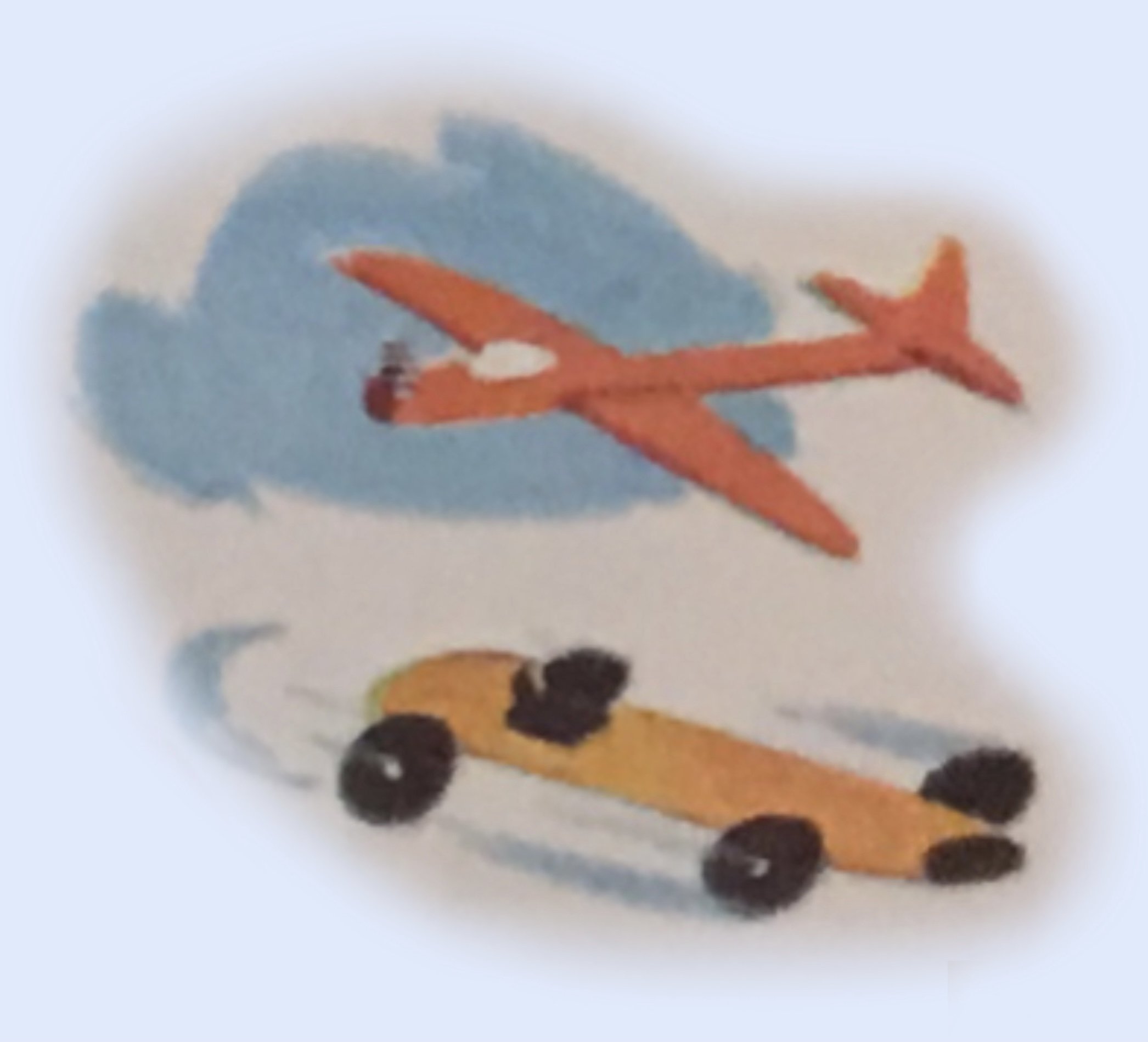

Cox “Thimble Drome” Flight Circle (1958 - January, 1966)
Much like WEN•MAC, a small company called L.M. Manufacturing had once expanded and grown beyond producing other toys (from wooden pop guns in 1941, to unpowered model cars in 1946). The year following a fire which completely destroyed his factory, Roy Cox produced the first wildly popular Thimble-Drome Champion racecar. A few years later (and owning to a very special arrangement between Leroy M. Cox’ L.M. Cox Manufacturing and Disneyland Inc.), Cox would become a lease-free Participant sponsor, providing an all-new and exciting Tomorrowland show as well as merchandise. Tomorrowland guests soon “joined the thousands who were enjoying today’s most thrilling outdoor sport with Thimble Drome Power Models.” With that, the Flight Circle gained yet another new sponsor and was renamed Thimble Drome Flight (or, Flying) Circle!
By the year 1958, the Flight Circle was considered one of 15 free educational shows and exhibits at Disneyland! Disneyland Tour Guides even highlighted the Cox Manufacturing-sponsored free exhibit and show for Tour Groups, from 1958 right up to construction of the New Tomorrowland. By September of 1958, an appraisal of Disneyland “land improvement” assets found the Flight Circle valued at $13,646. The stage was considered a asset (depreciating like all amusements and rides), soon appraised between approximately $5,450 and $6,000.
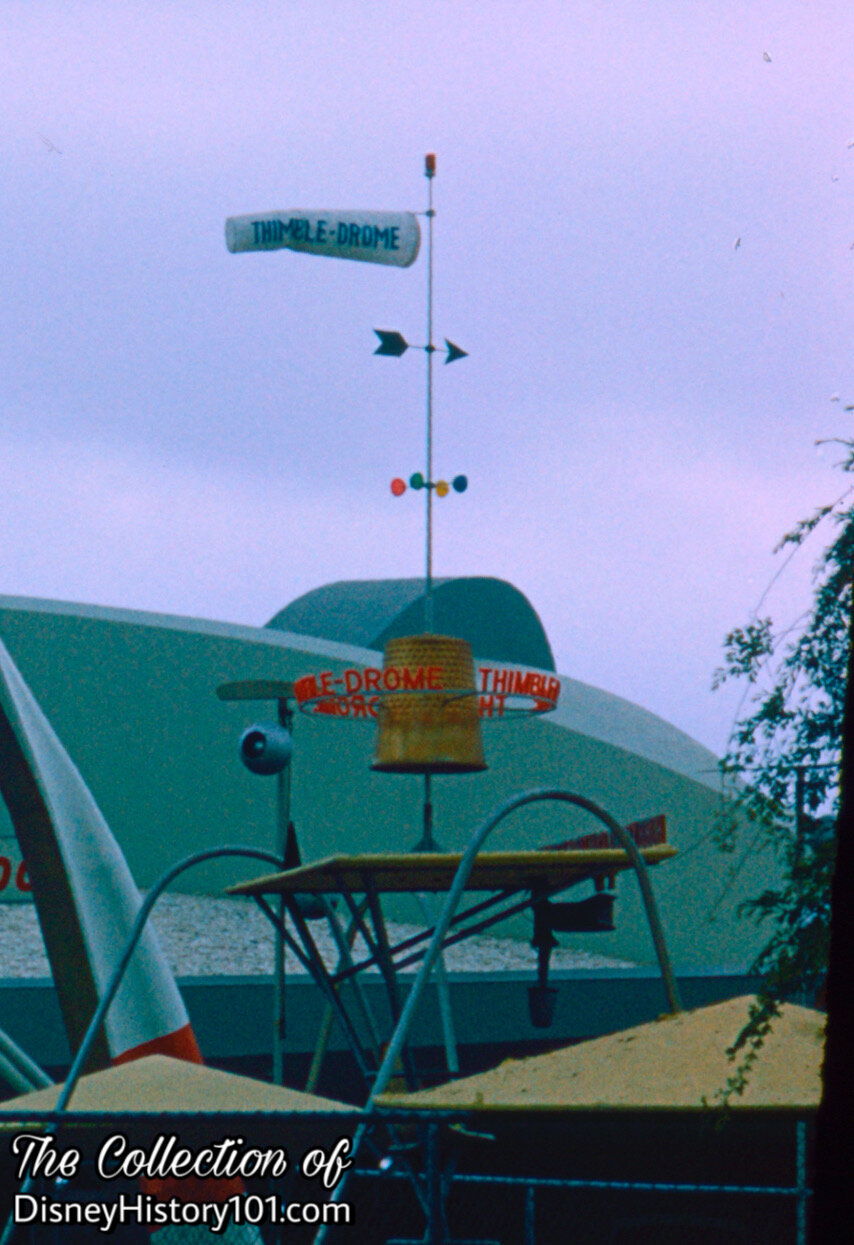
“WHAT IS ‘THIMBLE-DROME’?”
At Disneyland, signs were themed to support the stories with respectful graphics, colors, fonts, terminology, the overall design of sign, materials (wood, metal, banners, etc.), and verbiage used on the signage. This was the scene as Disneyland audiences approached the exhibit - a giant thimble and the circulating expression: “Thimble-Drome.” But what is a “Thimble-Drome”? The name of the second sponsor - Thimble Drome - was a combination of the word drome (meaning, “race course”), and Roy Cox’ once commercially available “Thimble Drome Special” model car (with a .045 inch, “thimble-sized” engine). These speedy miniature models were once a top-seller, and would race around the circular concourse situated in the center of Tomorrowland’s Hobbyland! U-Control aircraft pilots once wore special tie pins made from these small engines in advertisement of their products.
The windsock above the tower advertised the Cox Thimble-Drome name and also practically helped the employees performing demonstrations to determine the wind speed and direction. This was vital, because the operators maneuvered two (and even three) vehicles at one time.
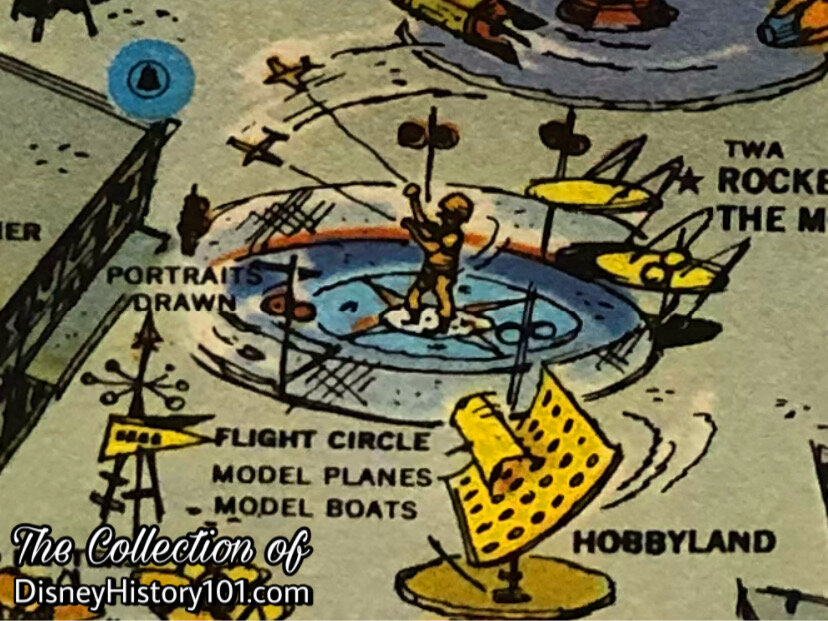
"Flight Circle" on Disneyland Fun Map by Sam McKim Excerpt, 1960s; © Walt Disney Company.
By 1959, Joe Fowler was Vice President of Disneyland Operations Committee, Jim Baker (Disneyland Merchandising) and Head Supervisor Vern Croft oversaw Hobbyland. Doc Lemmon of Disneyland Operations was overseeing Operators of Rides & Amusements (like the Thimble Drome Flying Circle), Livestock, Parking Lot, and Ticket Sellers. By this time, there was a major aviation theme in this area of Tomorrowland - AstroJets just north, and Rocket to the Moon to the east. The Thimble Drome Flying Circle zone (in the center) was the most popular and endured to the closure of Hobbyland. The map excerpt (above) features an operator demonstrating two model planes in the center of the Flight Circle. Though the area was called the Flight Circle, demonstrations of “model boats” were also performed in an aquatic area of the zone. Nightly these pools and fountains were cleaned.
The Thimble-Drome Power Model engines (which propelled their flight-tested planes), were known for their easy start. The planes then gave a thrilling show featuring “stunting, ‘dog fighting,’ dive bombing, speed dashes, and endurance flights,” according to Scramble magazine (published by Walt Disney Productions). As with the earlier Wen-Mac operator (“Big” Walt) - one pilot could even control up to three planes at once (these were tethered from the end of “Skylon Reels,” a device similar to reels used for kites)!
After the show, these Power Models could be purchased though Scramble! catalogues, and the assistance of Doug Young and Darrel Wilson (until they departed Disneyland during December of 1959). Replacement parts (Dubl-Tuf nylon props, Plane kits, Car kits, Boat kits, “Carry-All” cases (with tools), and even fuel were also available for order. To top out all off, Cox’ warehouse was conveniently located in neighboring Santa Ana! By this time (1959), Jim Baker (Disneyland Merchandising) was overseeing Hobbyland.
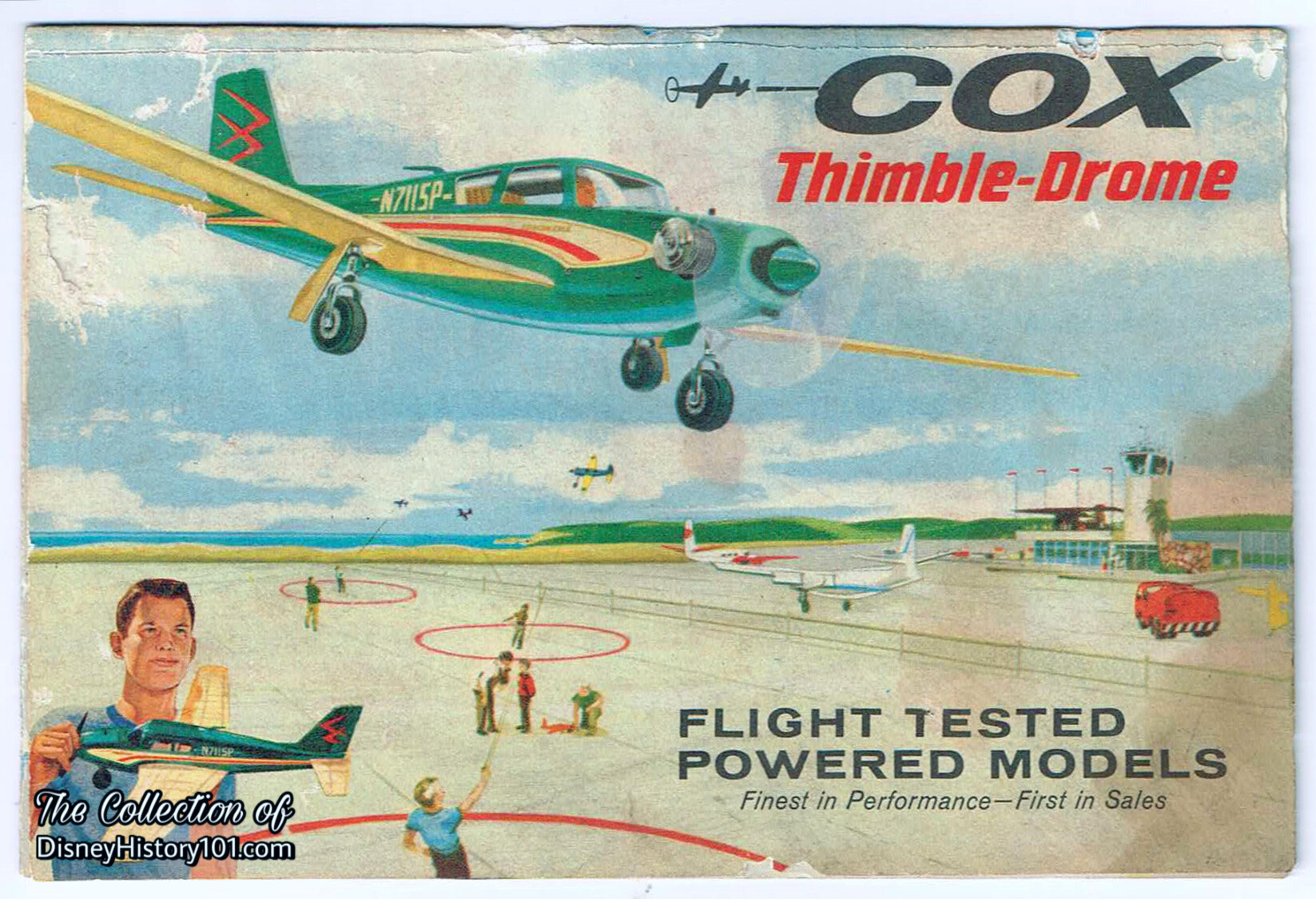
COX THIMBLE-DROME CATALOGUE
This catalogue (contemporaneous with Thimble Drome’s sponsorship) gives an idea of the merchandise displayed and available for purchase. You’ll note that many of the model planes cost somewhere in the $7.00-$10.00 range, with the highest-priced Comanche model running $25.00.
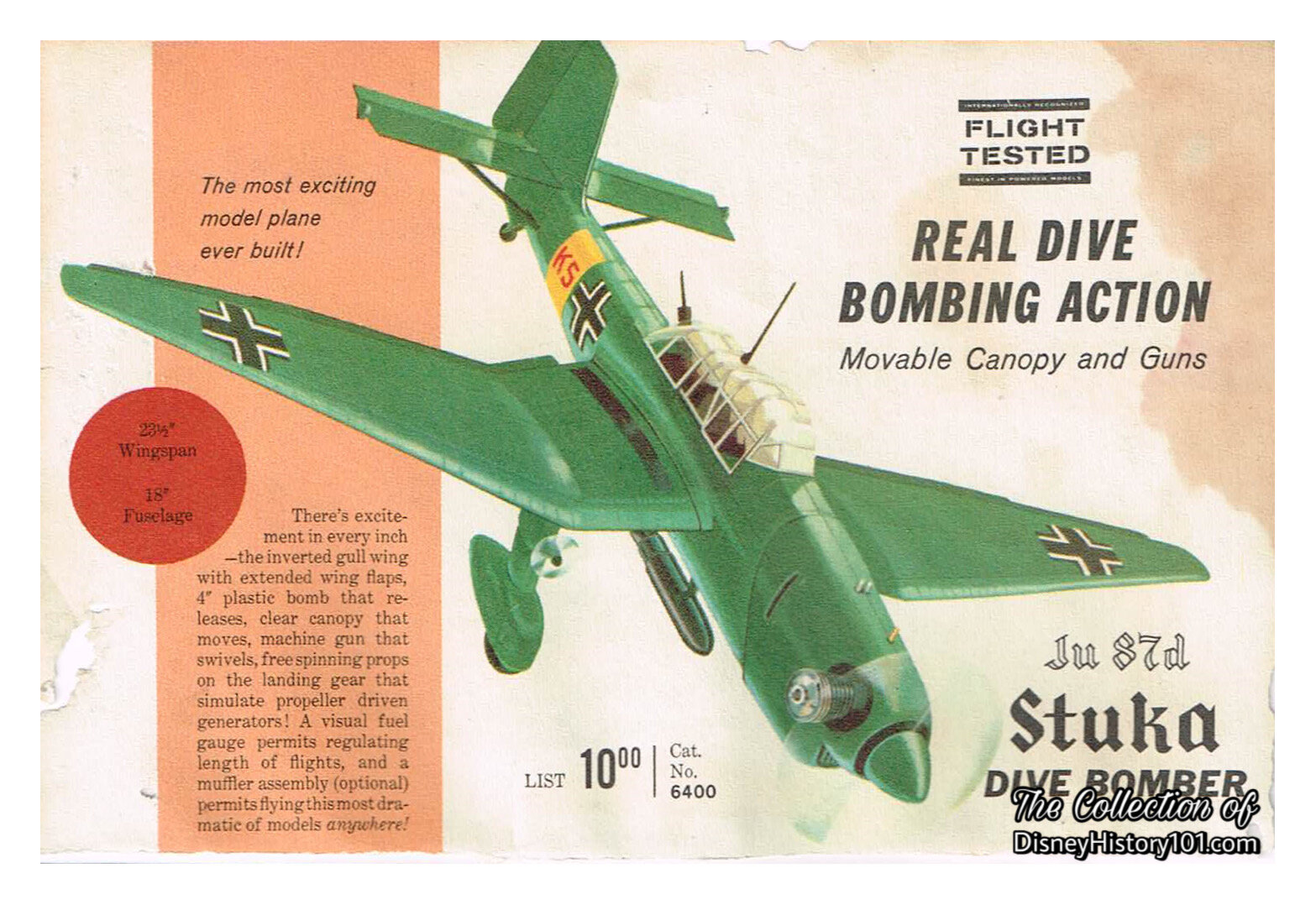
COX THIMBLE-DROME CATALOGUE
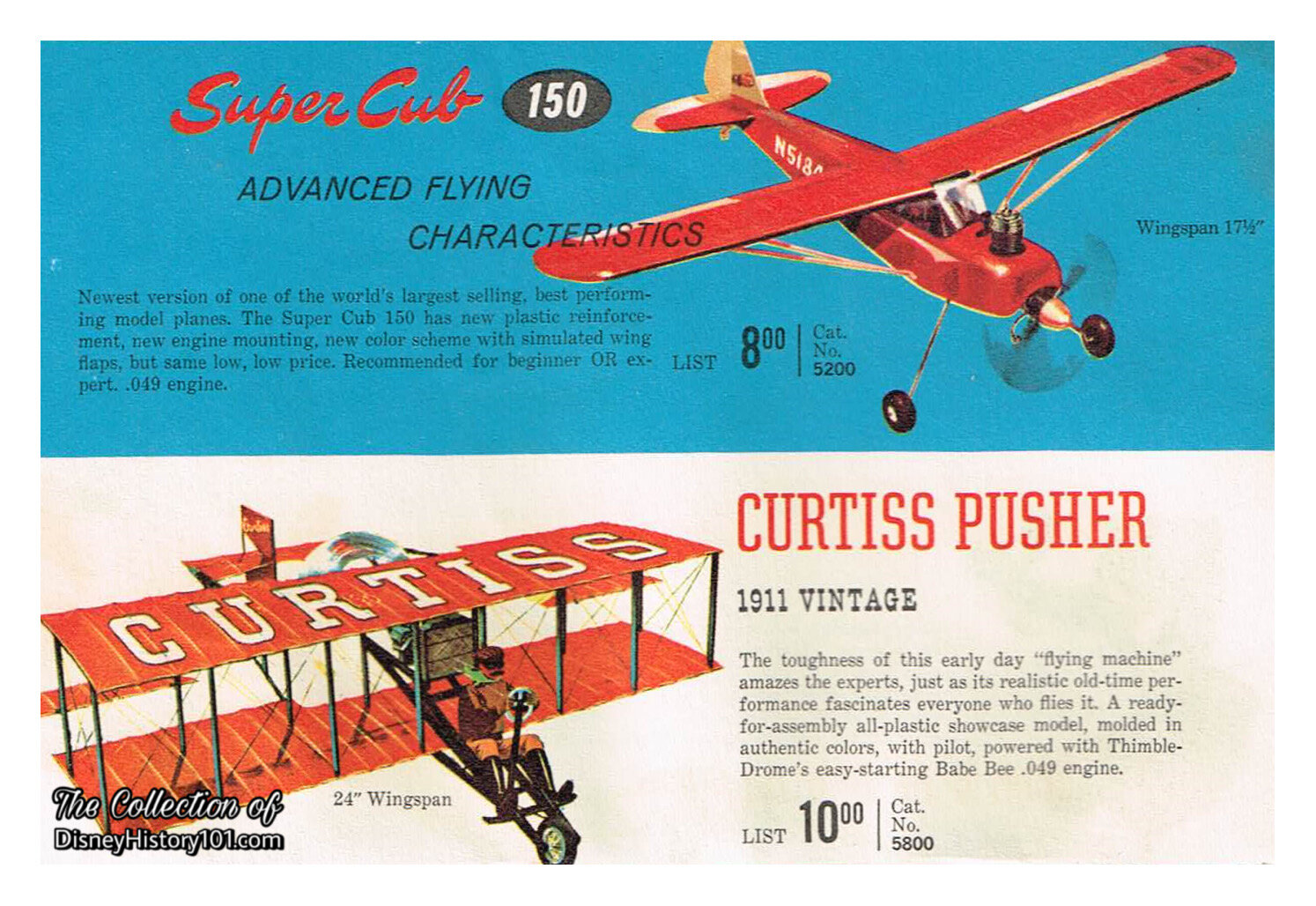
COX THIMBLE-DROME CATALOGUE

COX THIMBLE-DROME CATALOGUE
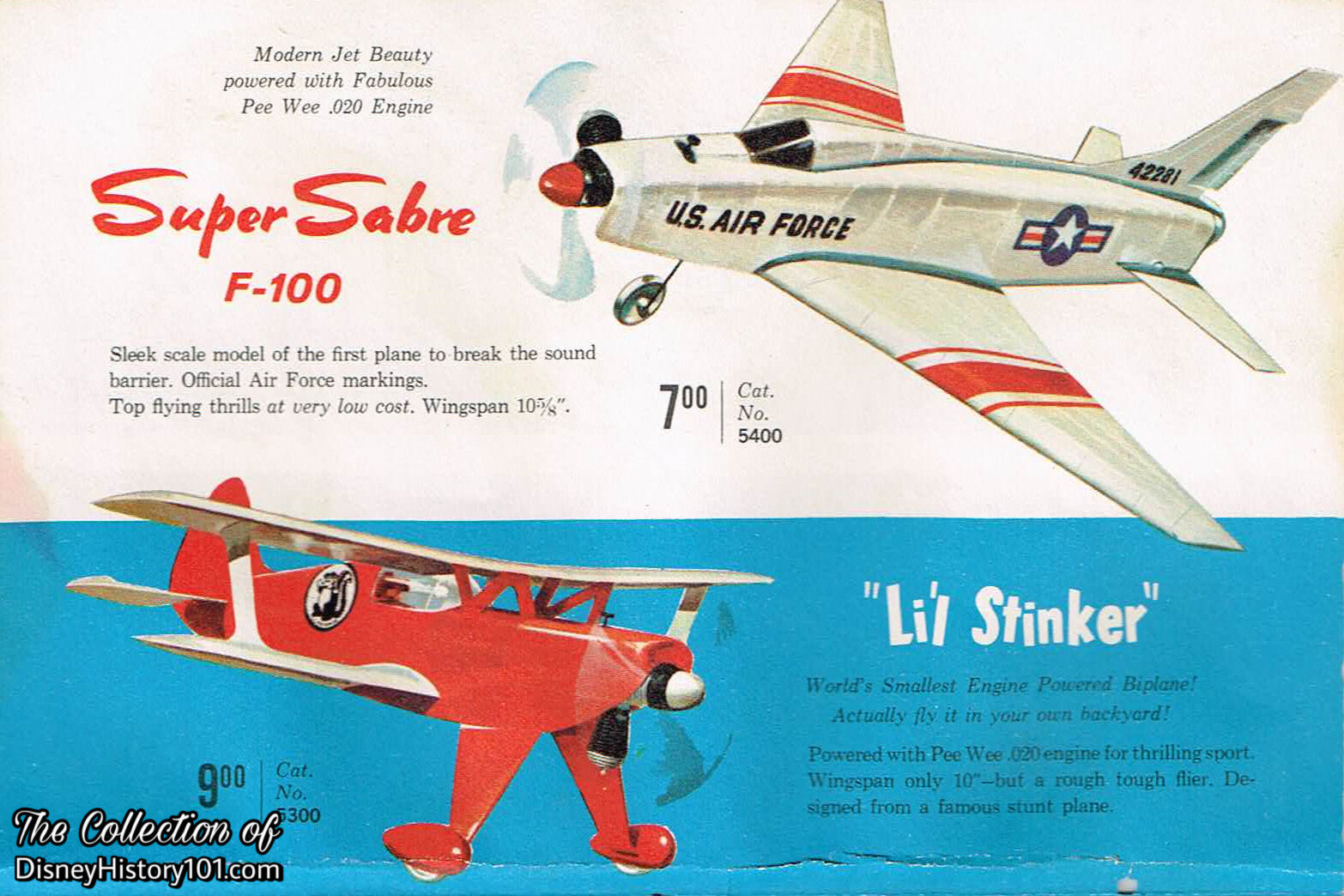
COX THIMBLE-DROME CATALOGUE
One “Foremost-Golden State Dairies” sponsored contest (held 1959) offered the opportunity to win a Grand Prize of “a ten-day American Airlines trip to Disneyland.” Of the 516 other big prizes were 200 (sixth prizes) - “P-40 Flying Tiger model airplanes powered by the famous Super-Bee Thimble-Drome engine. From the point of the prop spinner to the rudder its a fully detailed flying model, made by L.M. Cox Mfg Co.” Of course, one of the most popular models was the Lil’ Stinker (see image above; then retailing for $8.95) which was “built expressly for the fabulously tiny Pee Wee .020 engine! Half 1/2 A! Fuselage 9 1/4”! Wing span is 10” - high impact plastic, with jewel-like authenticity. . . from wing struts to covered landing gear. Complete equipped with Pee Wee .020 engine. Unbreakable spring starter,” according to “Disneyland Souvenir Gifts (published for 1958).
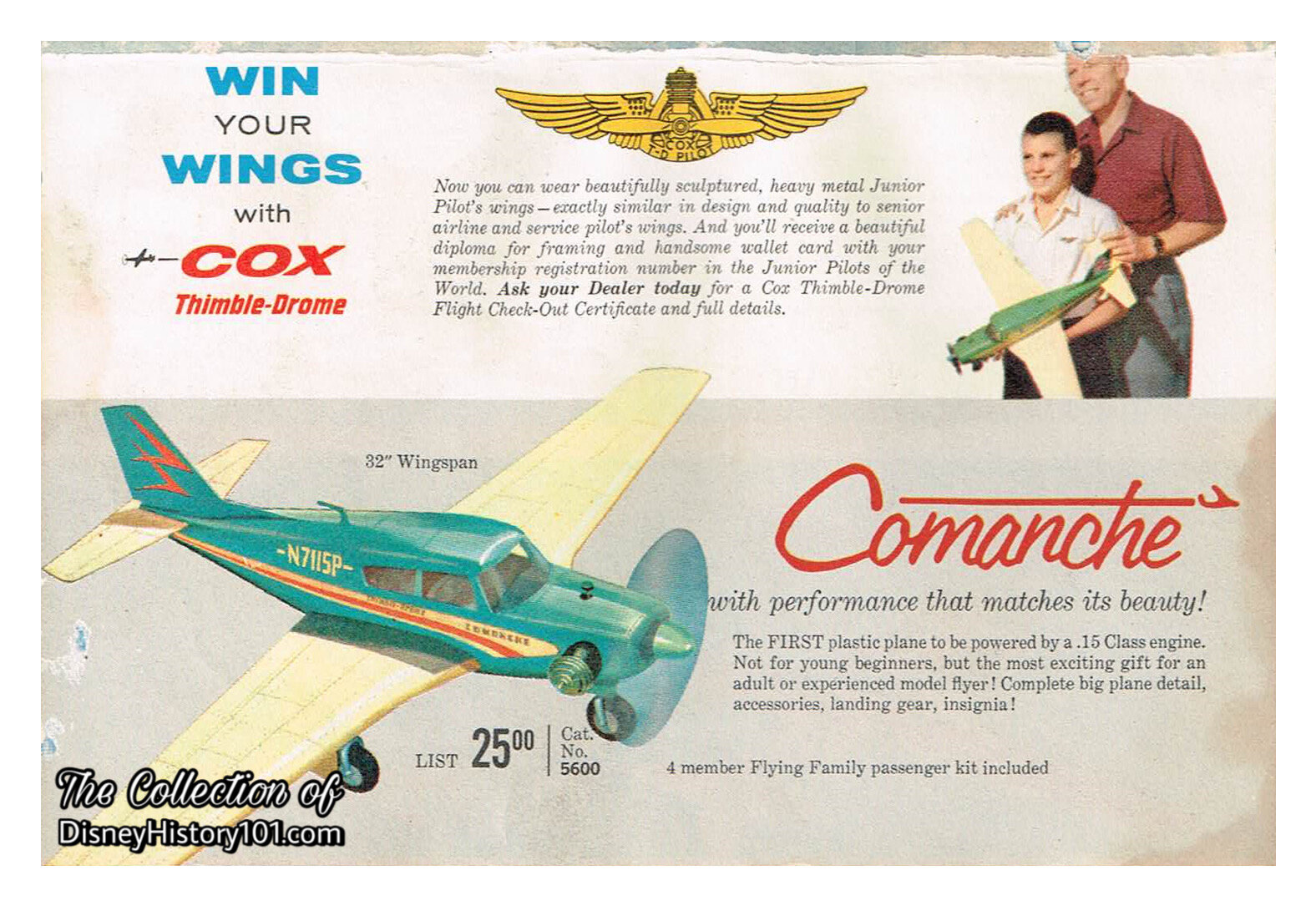
COX THIMBLE-DROME CATALOGUE
Summer meant the “familiar buzz of a WWI Sopwith Camel fighting with a Fokker or the whine of a high powered racing car” heard from the Hobbyland Flight Circle.“
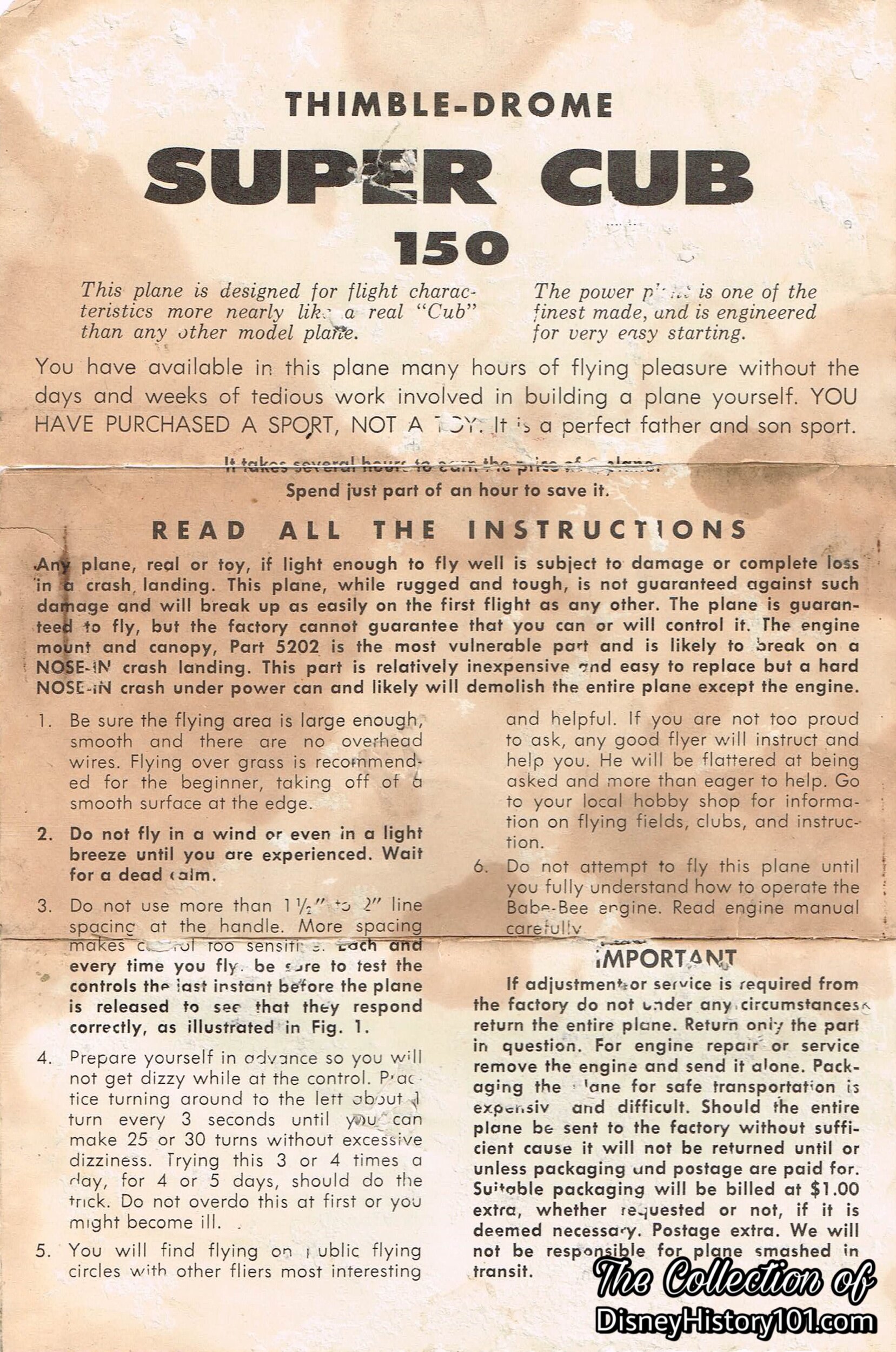

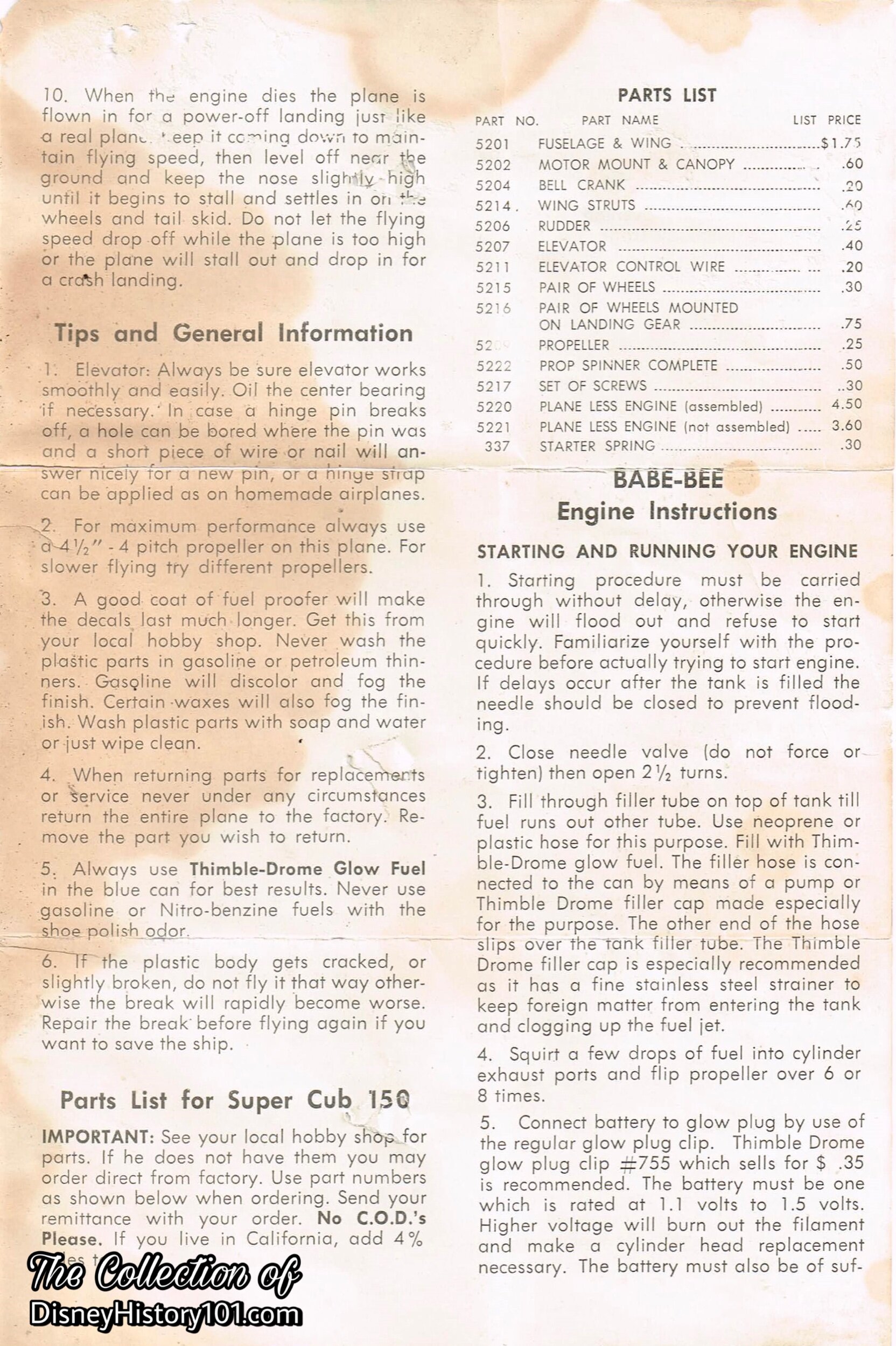
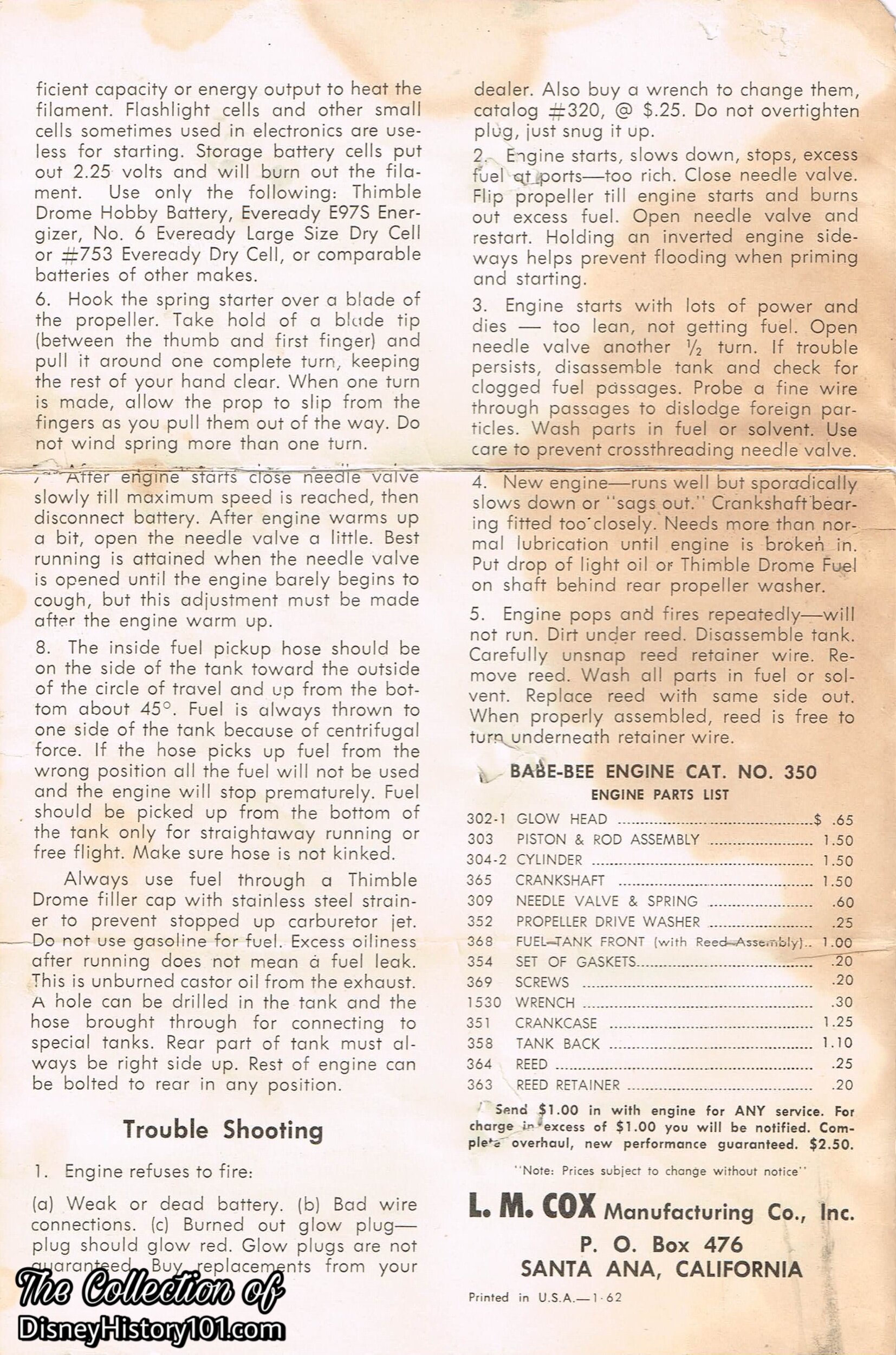
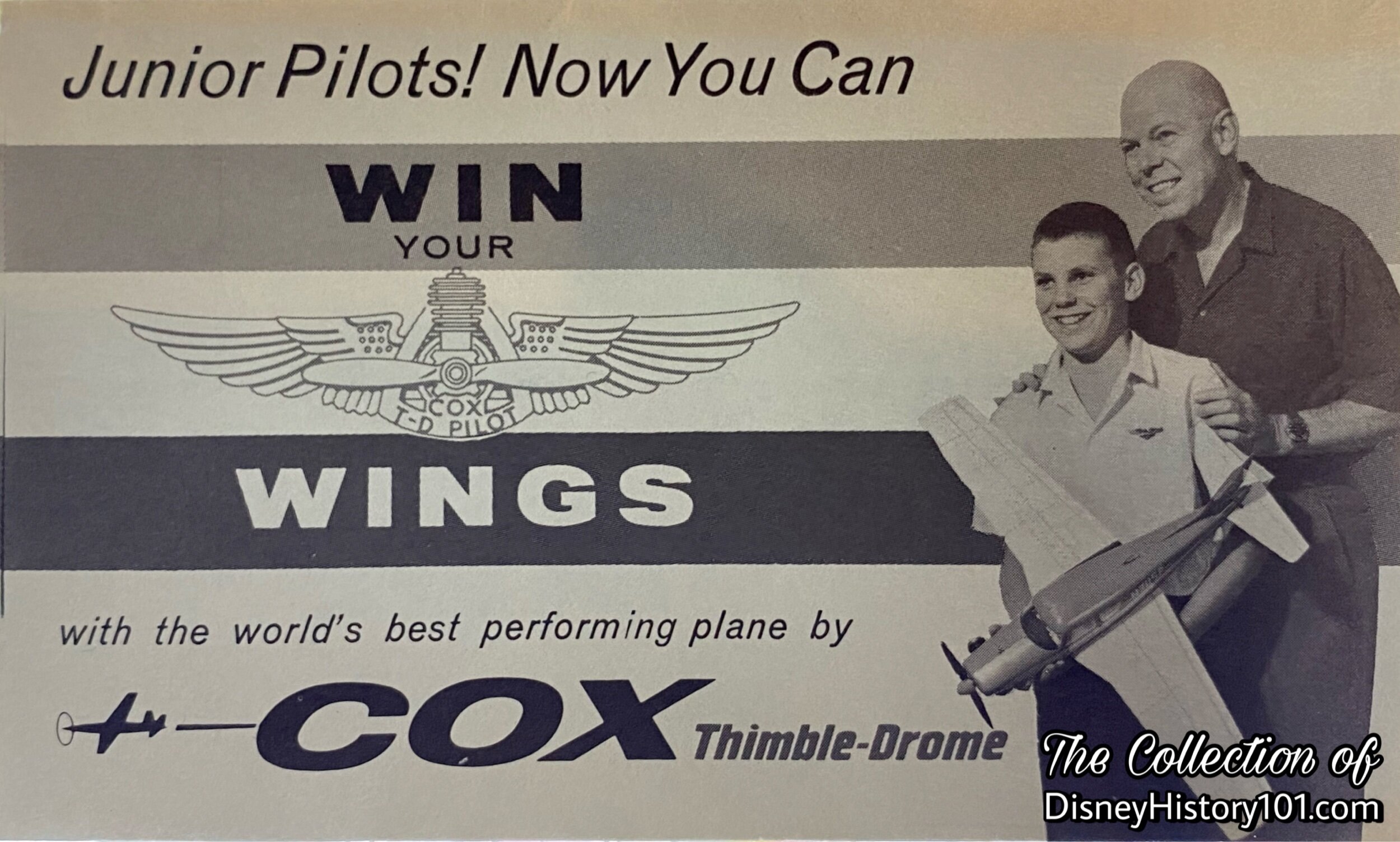
Cox Thimble-Drome "Win Your Wings" Form, c.1961-1962.
“If You Had Wings…”
Junior Pilots could win their wings (just like Wally) though filling out and submitting the form (after meeting operational requirements, of course). These planes may have seemed simple to control, but (by looking over the following instructional guides) one can discern that very much was involved.

Note the representation of a miniature engine on the Junior Cox Thimble Drome Pilot's Wings Pin.
These were in the style of those worn by both military and airline pilots. Perhaps you’ll recall the full-color Cox Thimble-Drome short film “Wally Wins His Wings,” produced in 1961 and distributed free of charge around 1962 for model clubs and hobby shops. Therein, Wally’s father narrates and explains how easy it is was for his son Wally to earn his burnished Junior Pilot's Wings by making your Junior Pilot Check-Out Flight. After earning their wings, young Disneyland pilots could also purchase them at $2.00 (retail value).
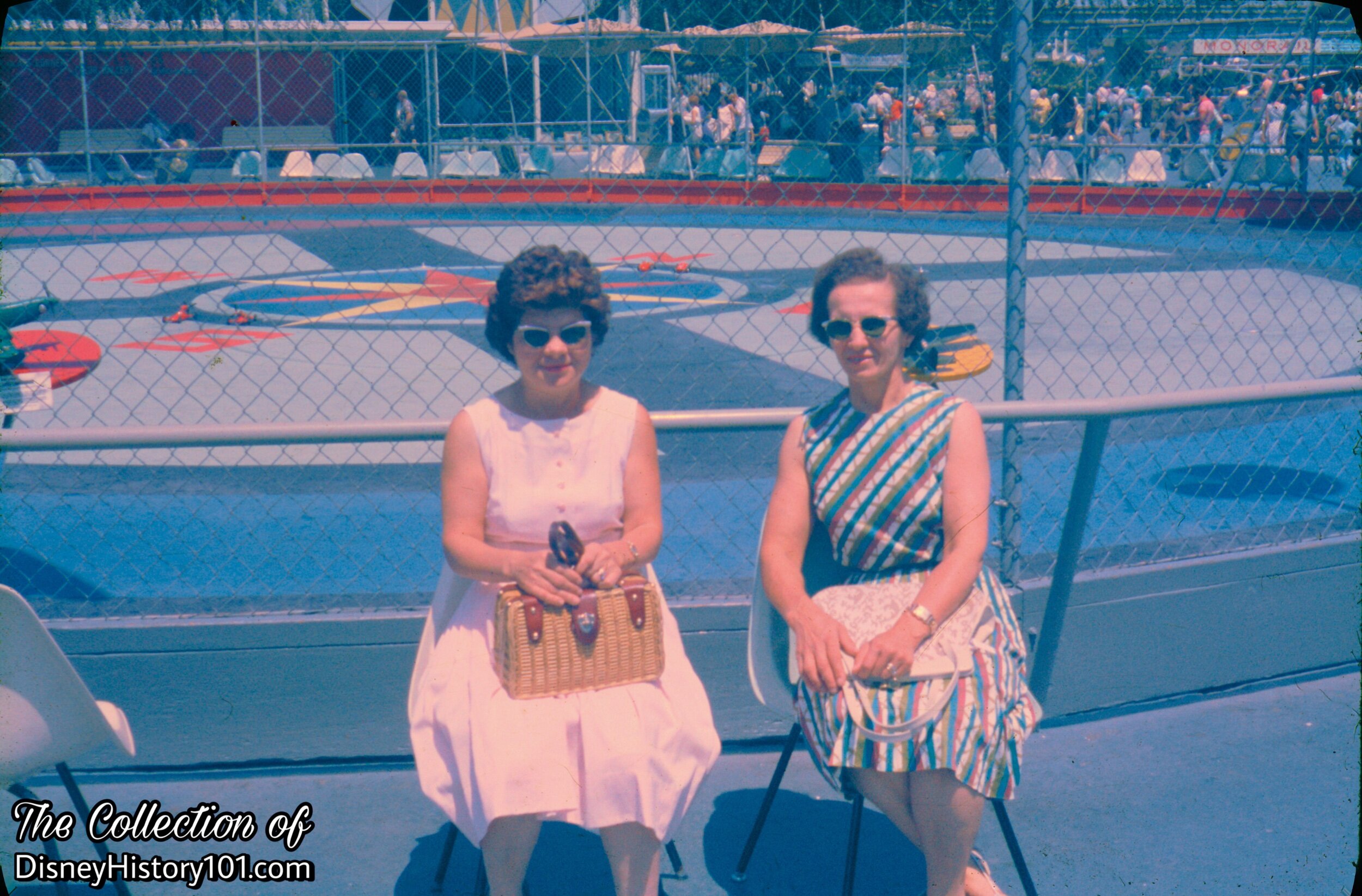
Thimble Drome Flight Circle Seating Area along the attraction periphery, c. 1958 or later
When shows weren’t running, guests would typically rest in the chairs surrounding the hub of Tomorrowland. Behind the guests, you might notice a couple of sets of red cars within the Flight Circle to the left, and center. Those were PROP ROD RACERS available (at $10.50) through “Gifts from Disneyland” catalogue as early as 1955. The description reads, “Powered by the famous Speed Bug Jr. engine, it runs free or tethered.”
Cox Scramble! magazine elaborates : “They circled at exciting speeds. Free running, it gives you dramatic road race or thunder bowl thrills as it zigs, zags, spins, and spills! Solid cast aluminum frame, machined aluminum wheels, 12-inch high impact plastic body, racing tread tires.”
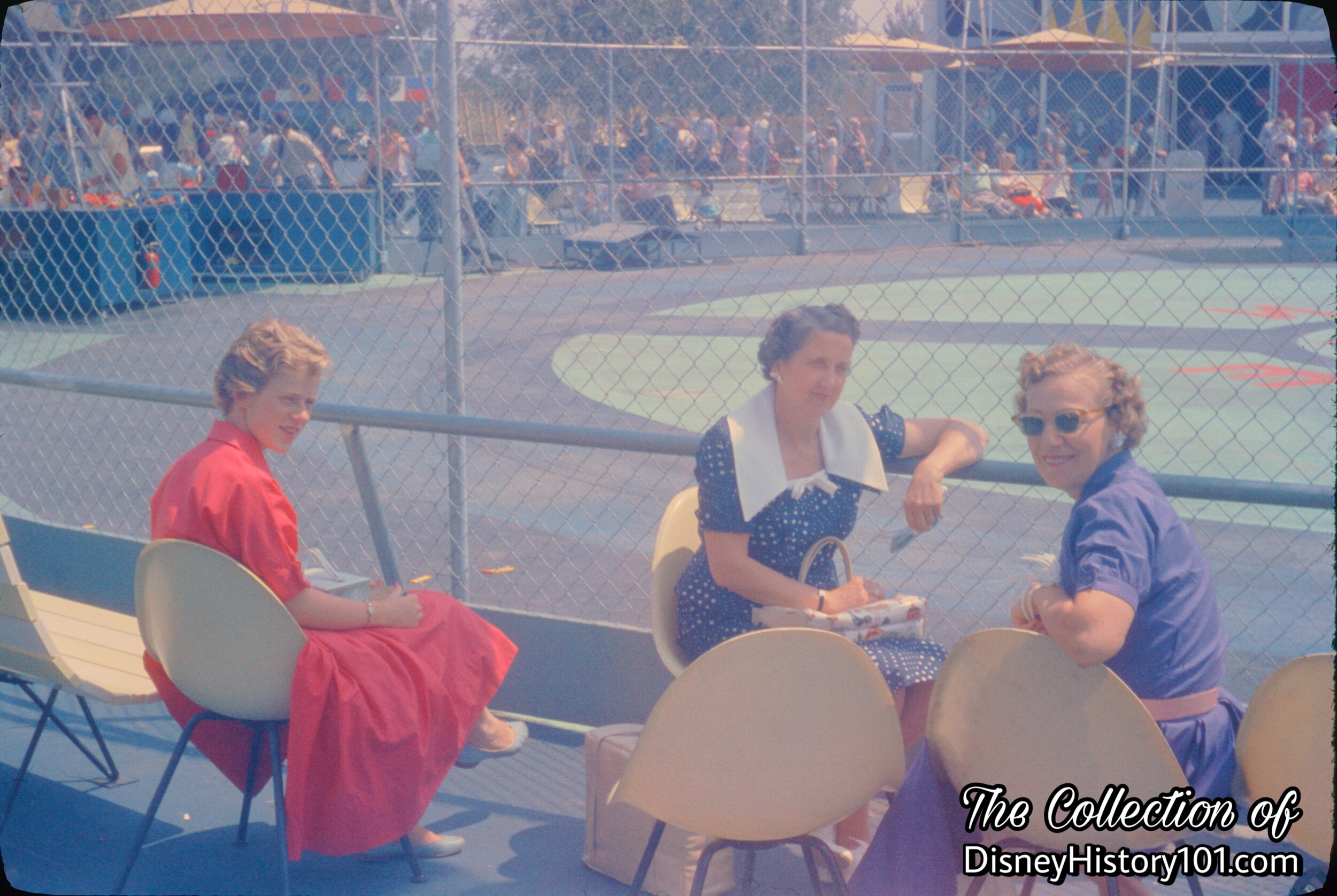
Thimble Drome Flight Circle Seating Area with audience.
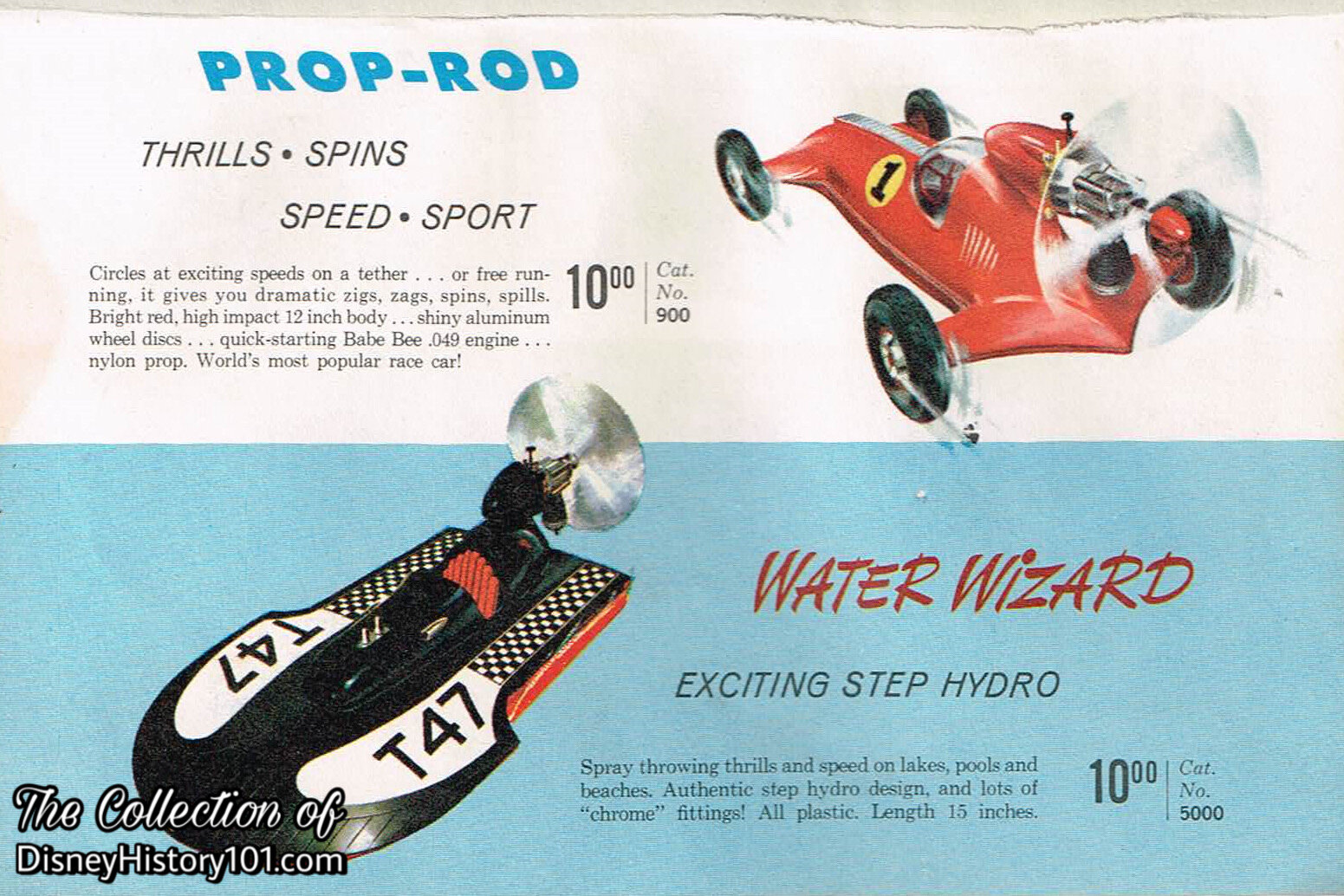
COX THIMBLE-DROME CATALOGUE
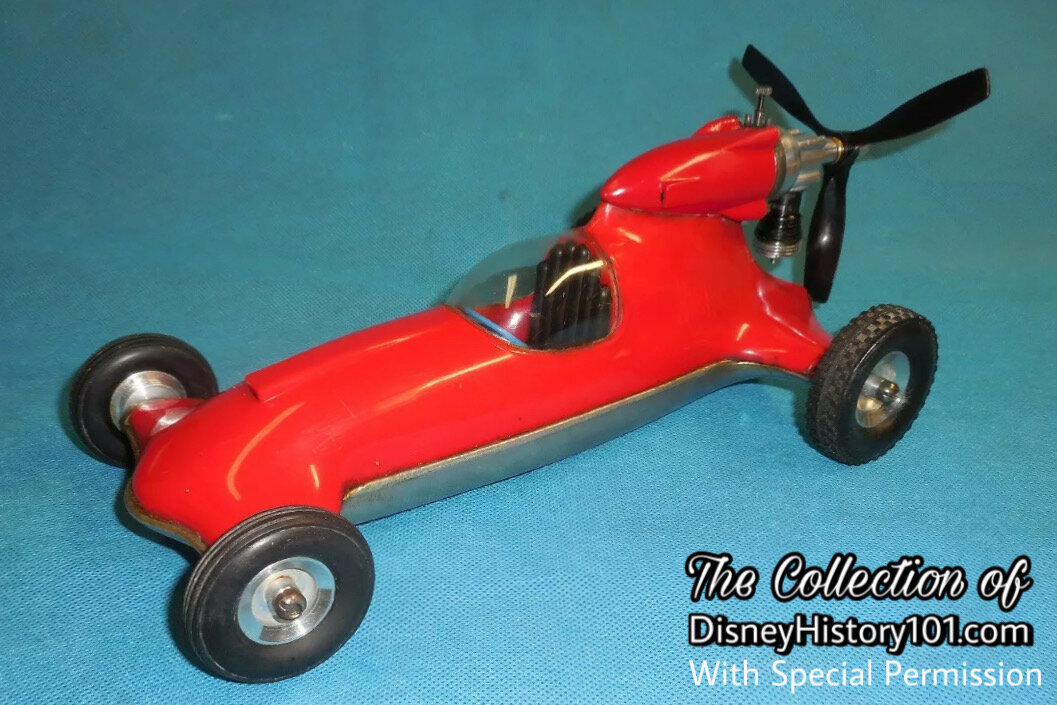
PROP ROD RACER
Cox Scramble! magazine elaborates : “They circled at exciting speeds. Free running, it gives you dramatic road race or thunder bowl thrills as it zigs, zags, spins, and spills! Solid cast aluminum frame, machined aluminum wheels, 12-inch high impact plastic body, racing tread tires.”
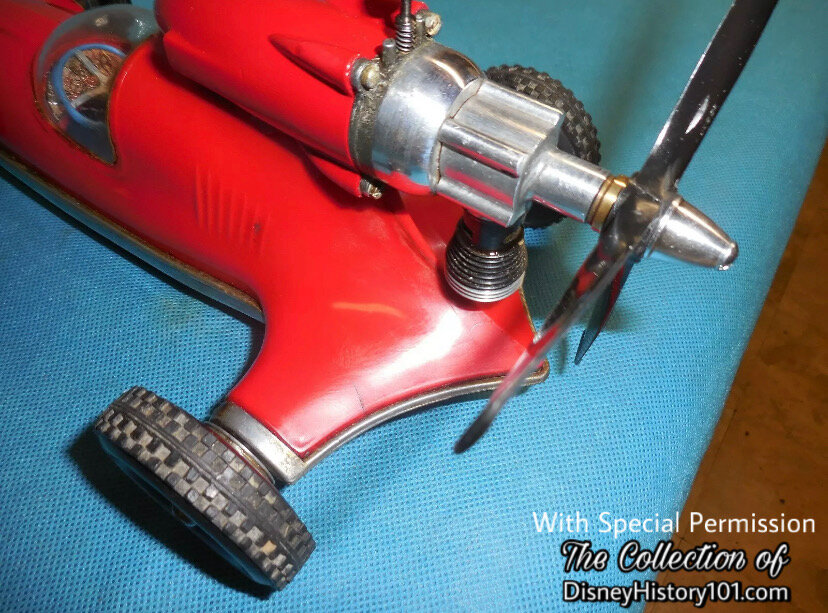
PROP ROD RACER
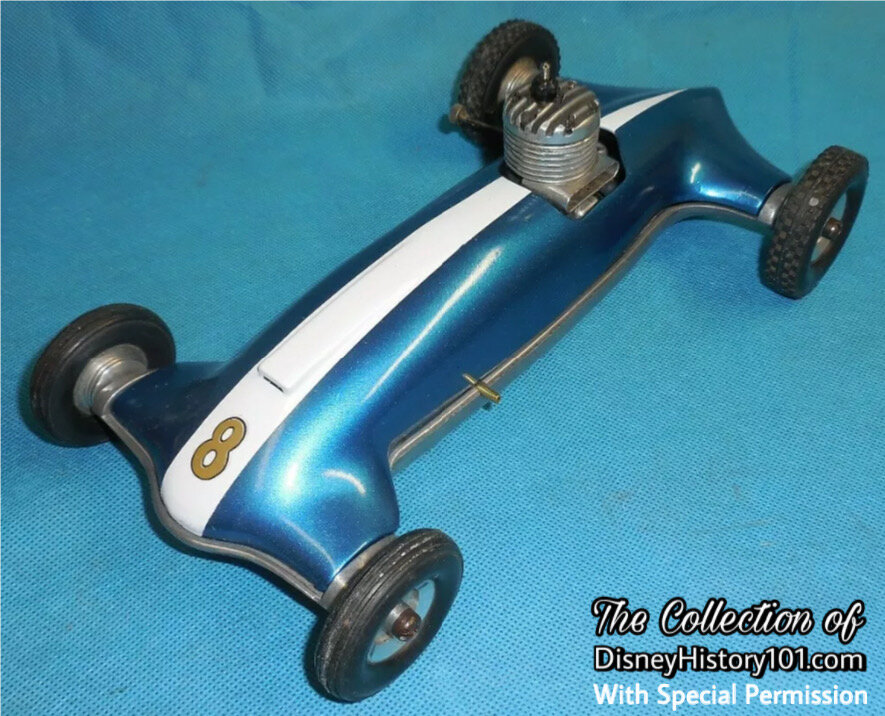
PROP ROD RACER
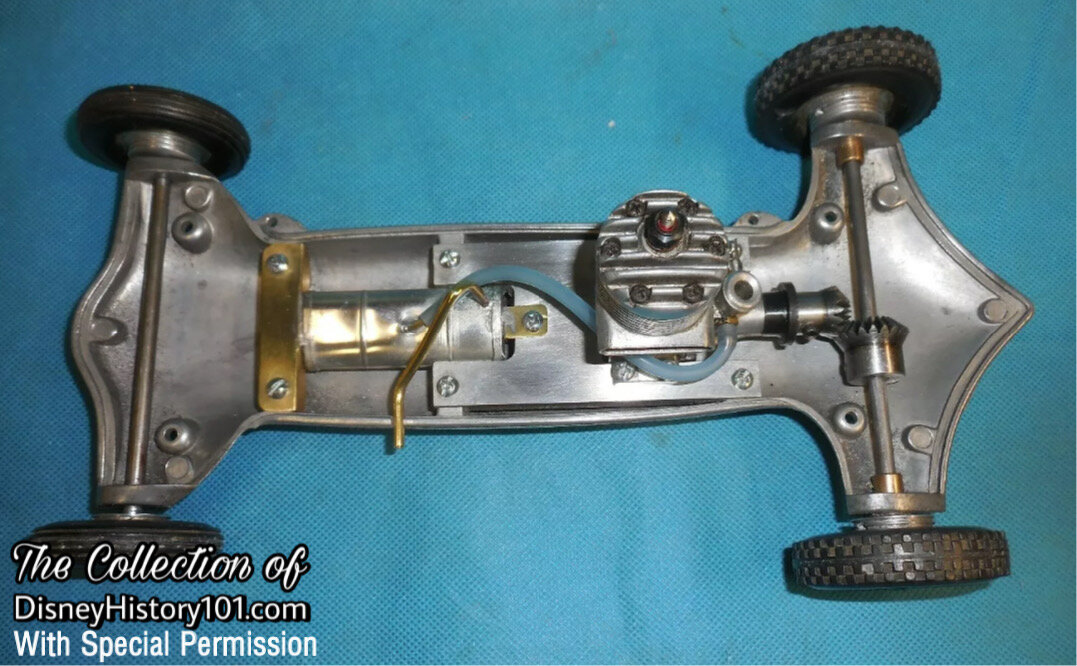
PROP ROD RACER
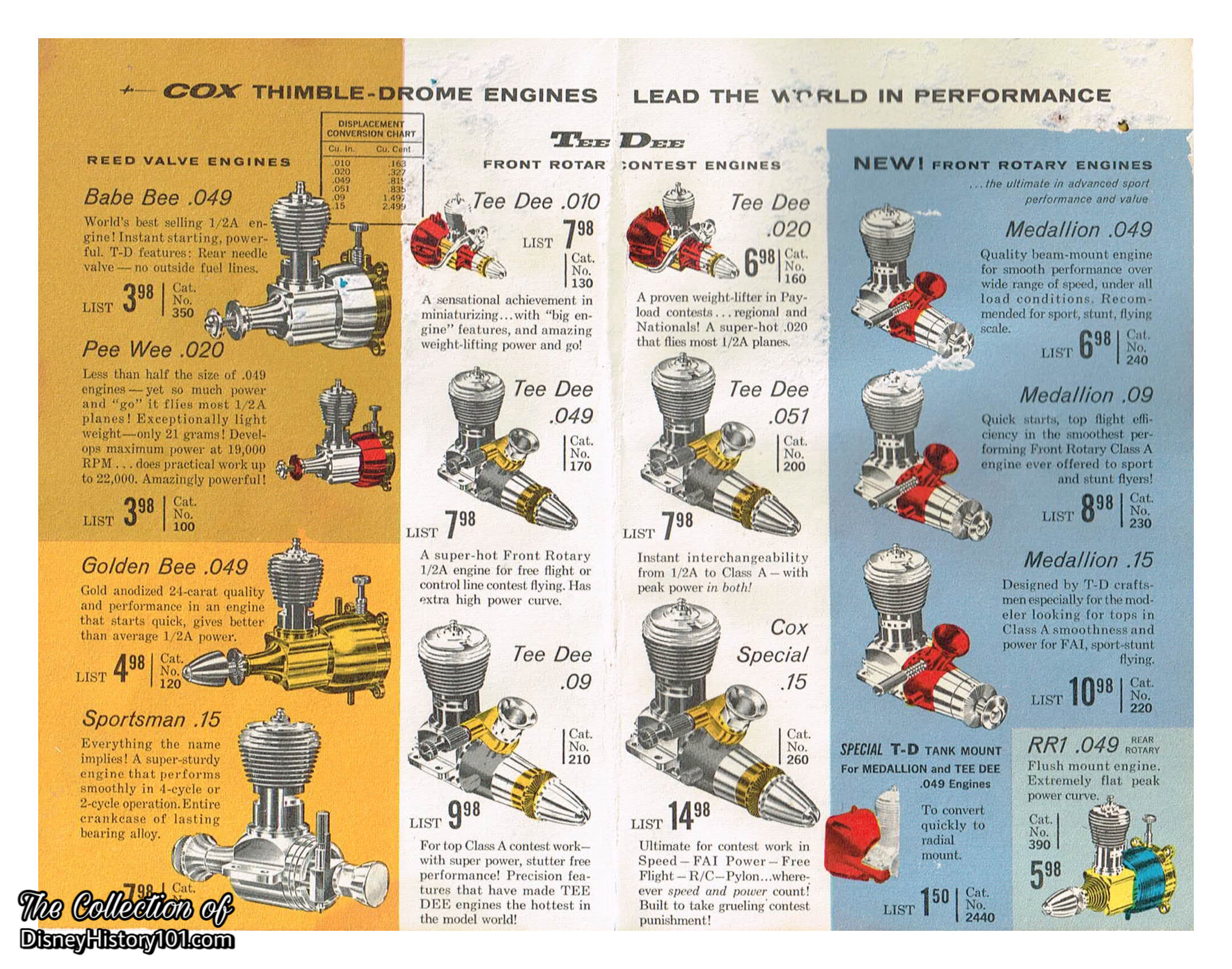
COX THIMBLE-DROME CATALOGUE
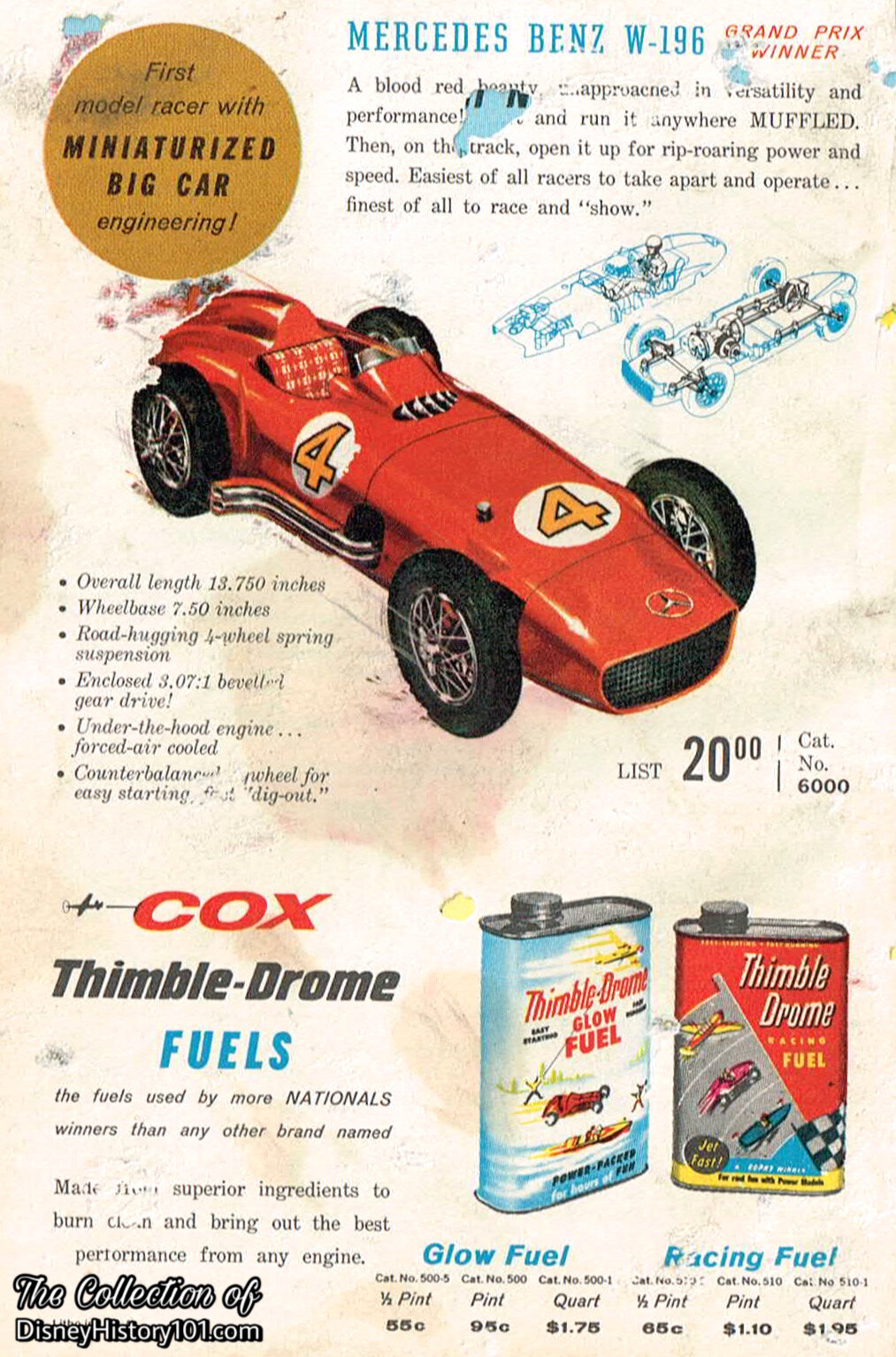
COX THIMBLE-DROME CATALOGUE
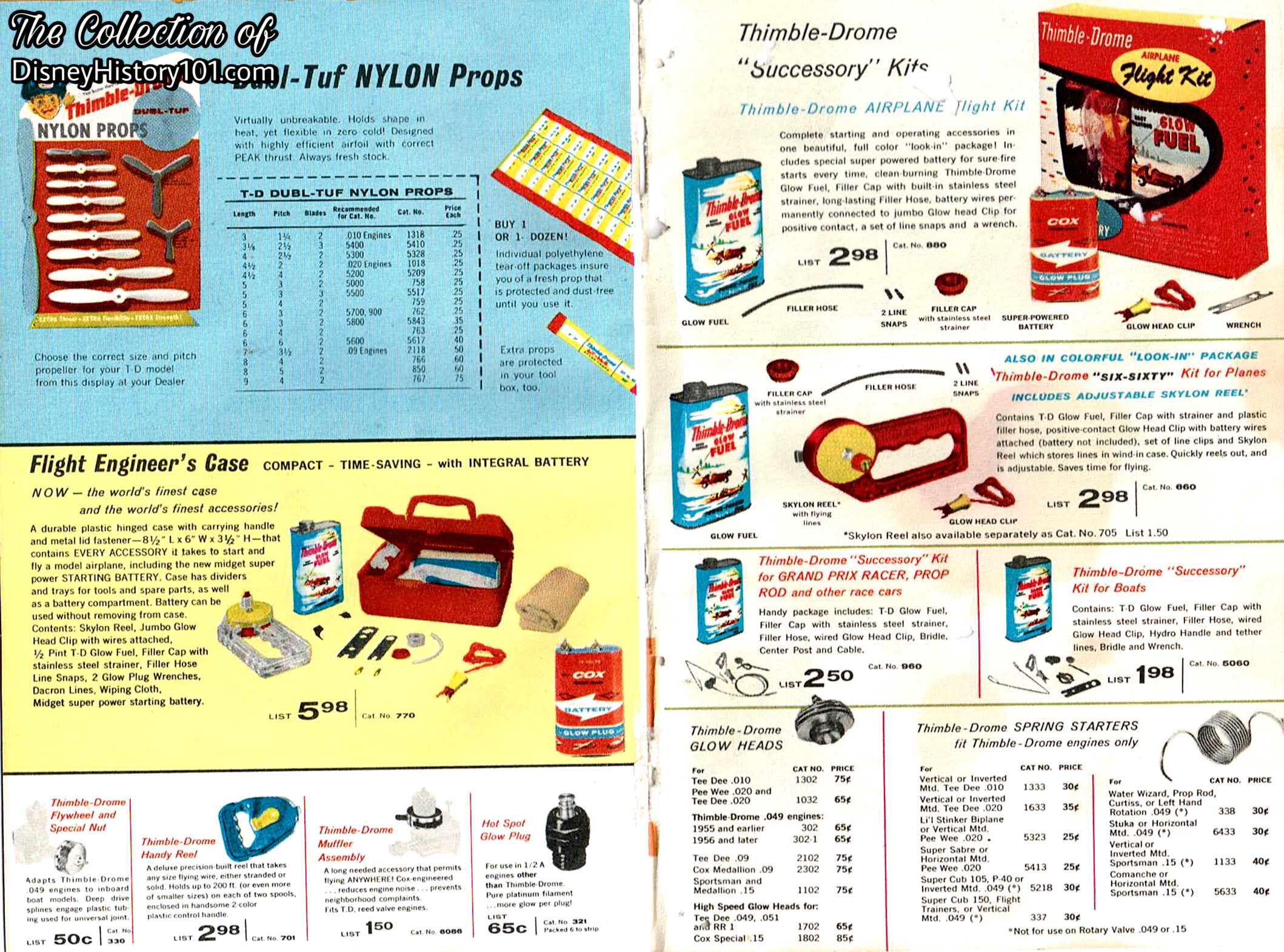
COX THIMBLE-DROME CATALOGUE
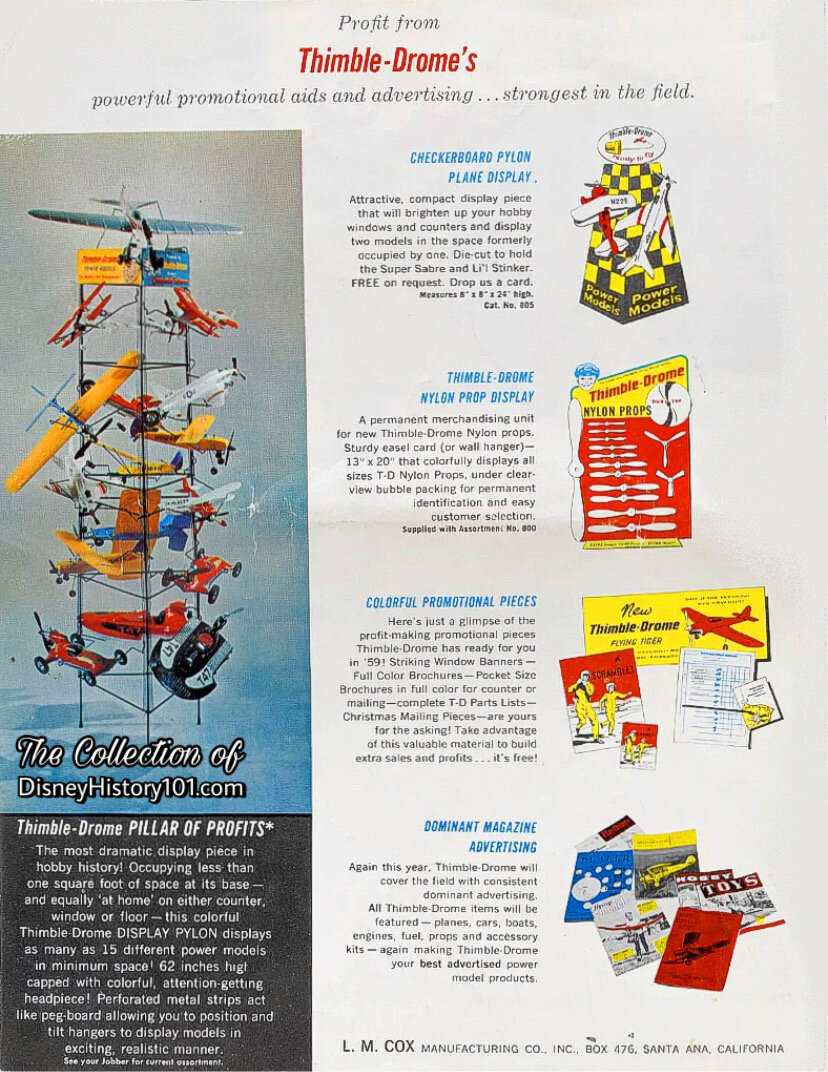
COX THIMBLE-DROME CATALOGUE
You may recall the 62” Thimble-Drome Display Pylon displaying up to 15 high-powered do-it-yourself kits and working models in the “Hobbies” location.
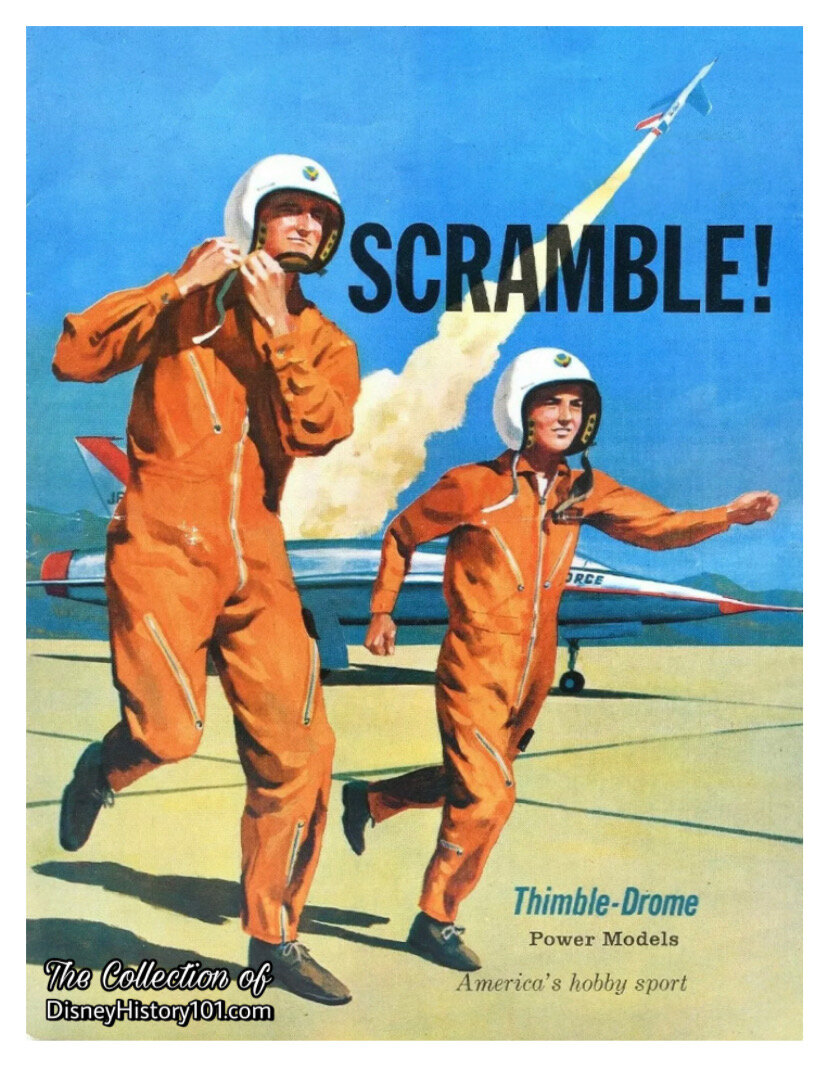
The cover of Scramble! Thimble-Drome Magazine.
Promotional pieces like Scramble! magazine were available as early as 1959.
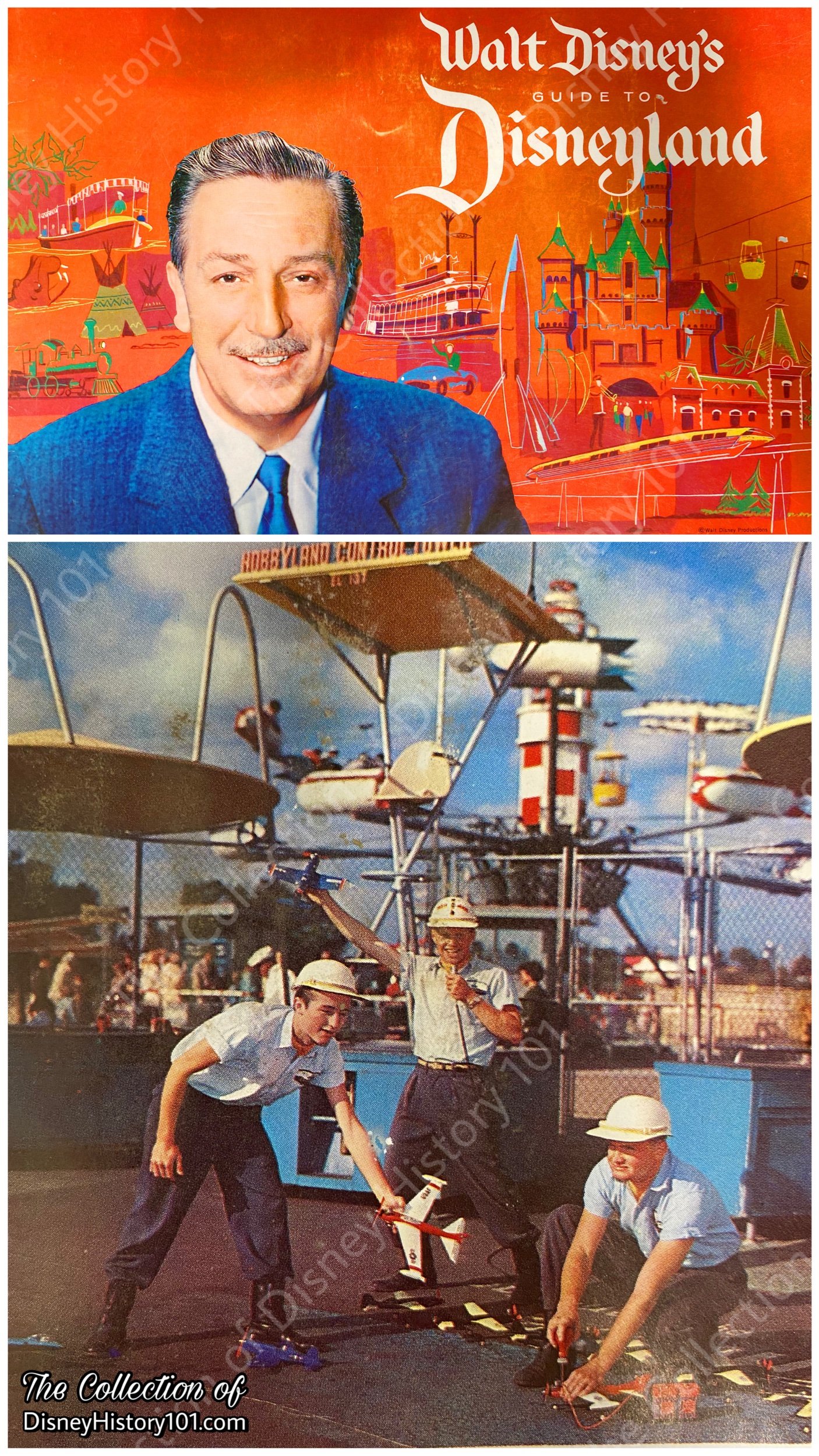
“Walt Disney’s Guide to Disneyland,” published 1961.
Back in 1961, a good show began with each individual Cast Member!
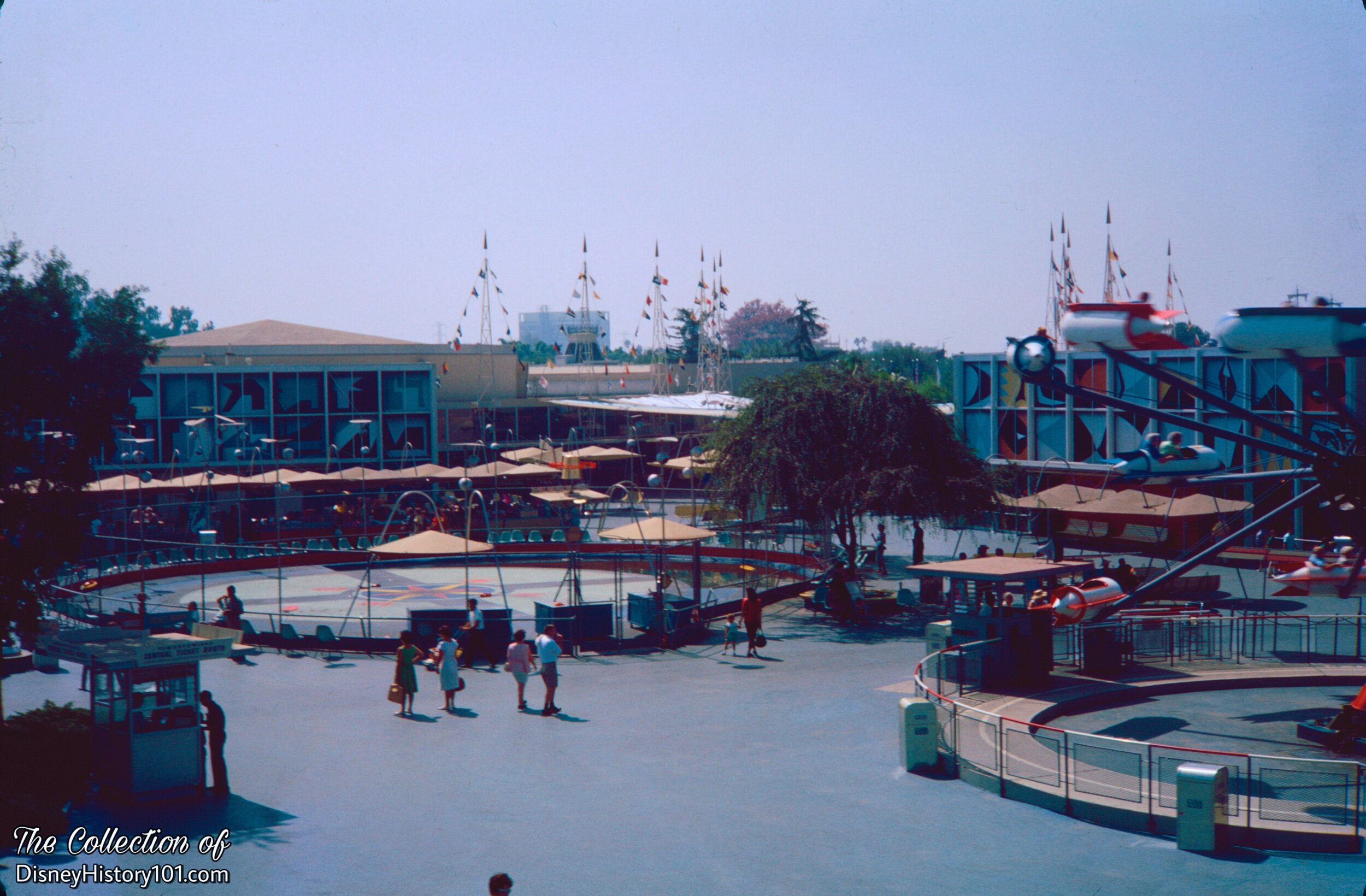
Thimble Drome Flight Circle, (September, 1962)
Just ahead lies the Thimble Drome Flight Circle in the hub of Hobbyland! While guests maneuvered their very own AstroJet from the cockpit (to the right), Flight Circle Operators took control of miniature Thimble Drome planes and jets (pictured to the left).
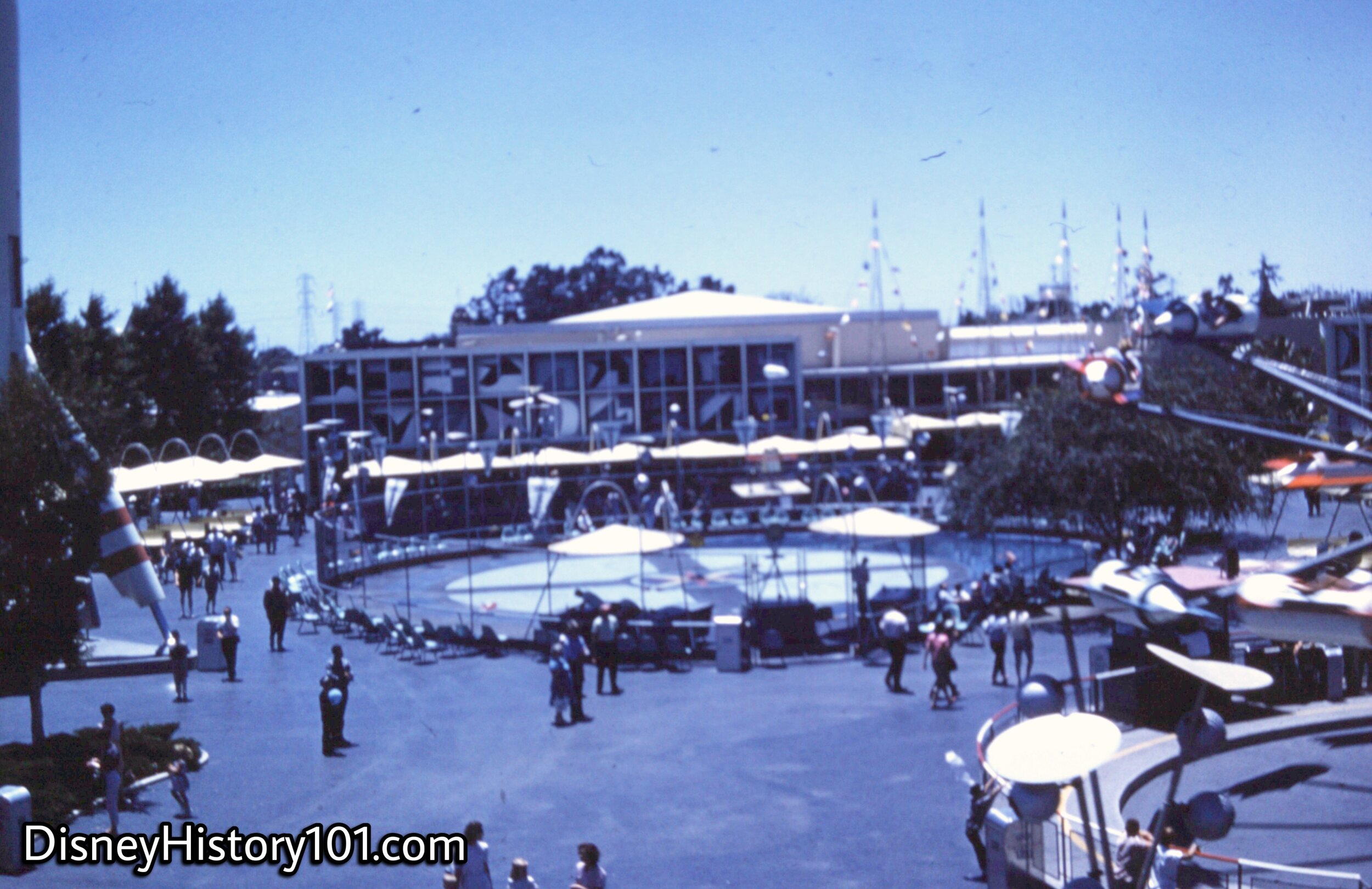

You are not looking at some illusion or some sort of special effect for a theatrical film, but a “true-life” man in flight! “The Rocket Belt consists of a twin nozzle hydrogen peroxide…propulsion system mounted on a fiberglass corset, which is secured to the operator by quick-release safety belts,” according to Backstage Disneyland (Spring, 1966).
Soon, during the holiday season of both 1965 and 1967, an amazing “performance” took place four times daily over the rooftops of Tomorrowland - the Bell System Rocket Belt Flight test! Several demonstrations had previously taken place as early as 1961 (by a Mercury Astronaut), during 1963.
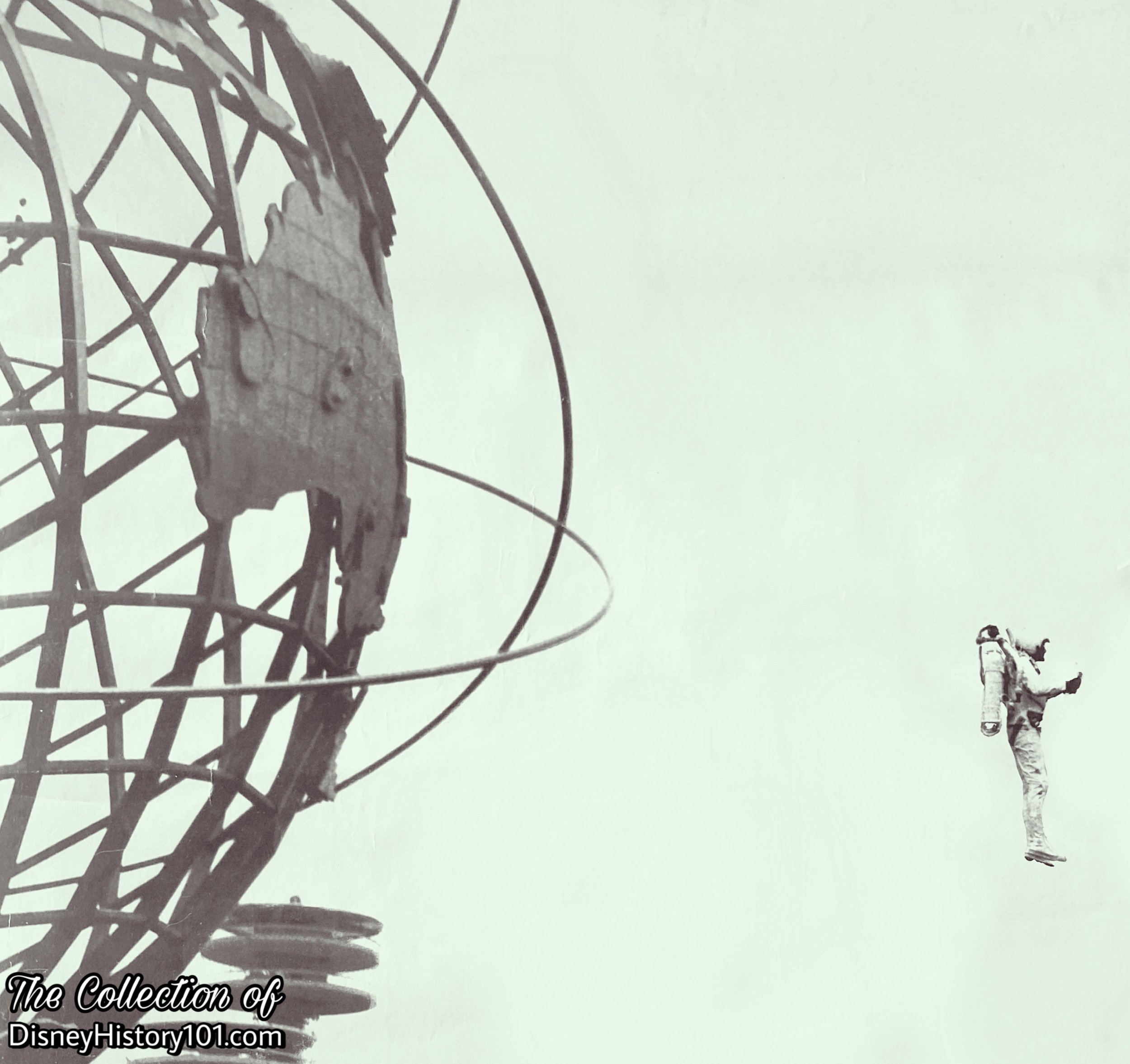
There were also sightings of “Rocket Man” flying over the Unisphere via jet-propelled, steam-powered back-pack, at the New York World's Fair of 1964-1965.

Promotional Bell System Rocket Belt Flight Test Press Photo
However, this was the first time that a Bell Aerosystem’s Rocket Belt Flight Test occurred inside Walt Disney’s Magic Kingdom, exhibiting “aviation’s progress and its fantastic promise” for Tomorrowland guests! One Rocket Belt Pilot (Robert F. Courter Jr.), was a veteran pilot with combat flight experience in World War II and Korea. Now, from this point forward, he could add Disneyland performer to his resume!
In the following document, travel arrangements and living accommodations were made for the two pilots and all those involved in producing this special show!
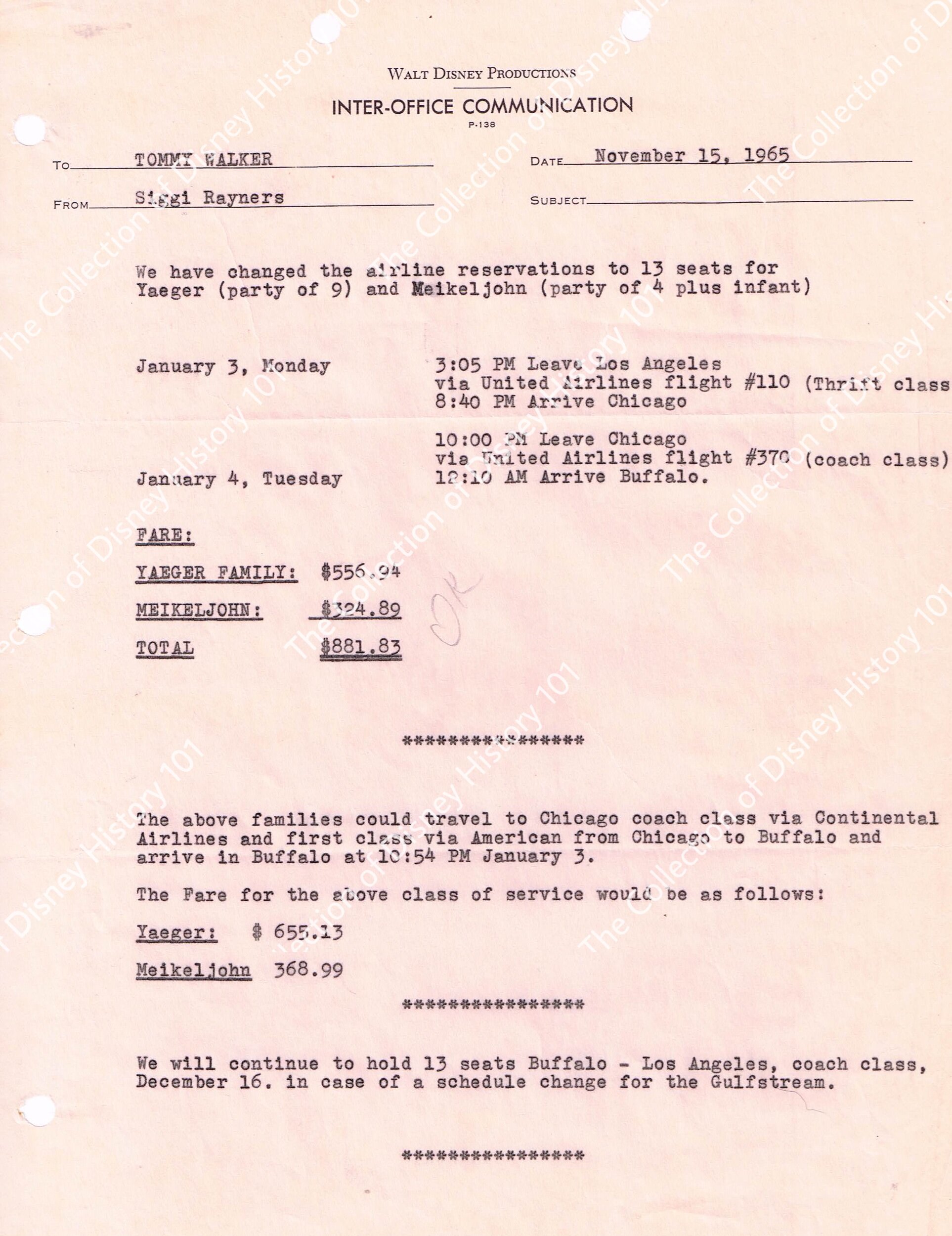
Walt Disney Productions Inter-Office Communication, (November 15, 1965)
Stuntman Gordon Yeager (no relation to Charles “Chuck” Yeager, test pilot of the Bell X-1 supersonic jet) had piloted the Bell Systems Rocket Belt at the 1964 New York World’s Fair. He and his family would also be invited to attend the Bell Systems Rocket Belt flight at Disneyland (all airline accommodations arranged). Gordon Yeager would be joined by Bill Suitor (who would also pilot the Bell Systems Rocket Belt), and Textron’s Bell Aerosystems Rocket Belt Technician Team rocket technicians Bill Burns, Edward Gaiser, and Doug Meiklejohn, according to Backstage Disneyland (Spring, 1966).
Ben Harris (of Disneyland Operations) was contacted, inquiring about room accommodations and travel arrangements for all of the pilots and their family members. In addition, an inquiry was made as to whether Walt Disney’s personal Beechcraft Queen Air plane was going to be made available to transport the 20 guests to their destination in California.
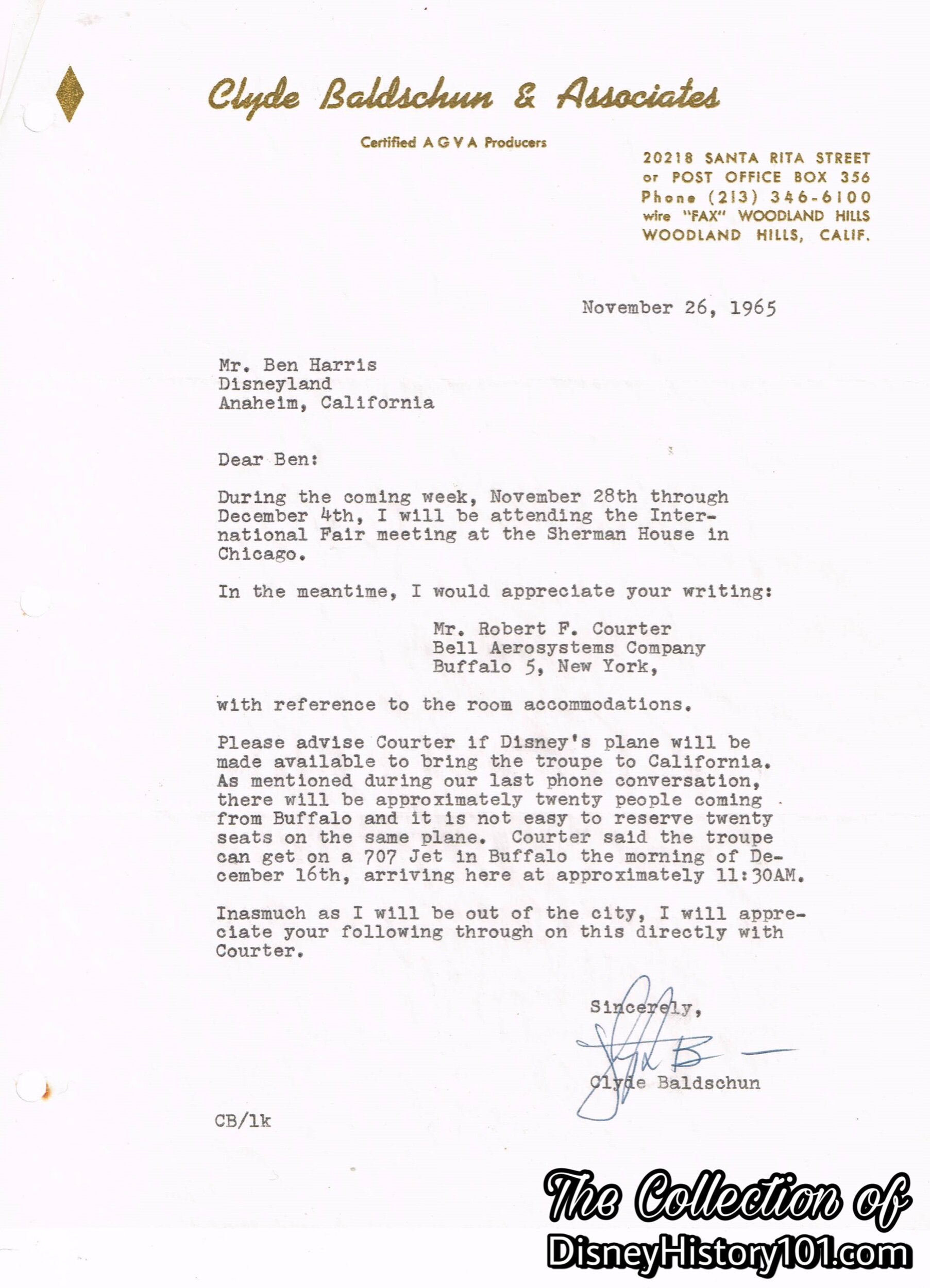
Letter From Clyde Baldschun & Associates to Ben Harris

Walt Disney Productions Inter-Office Communication
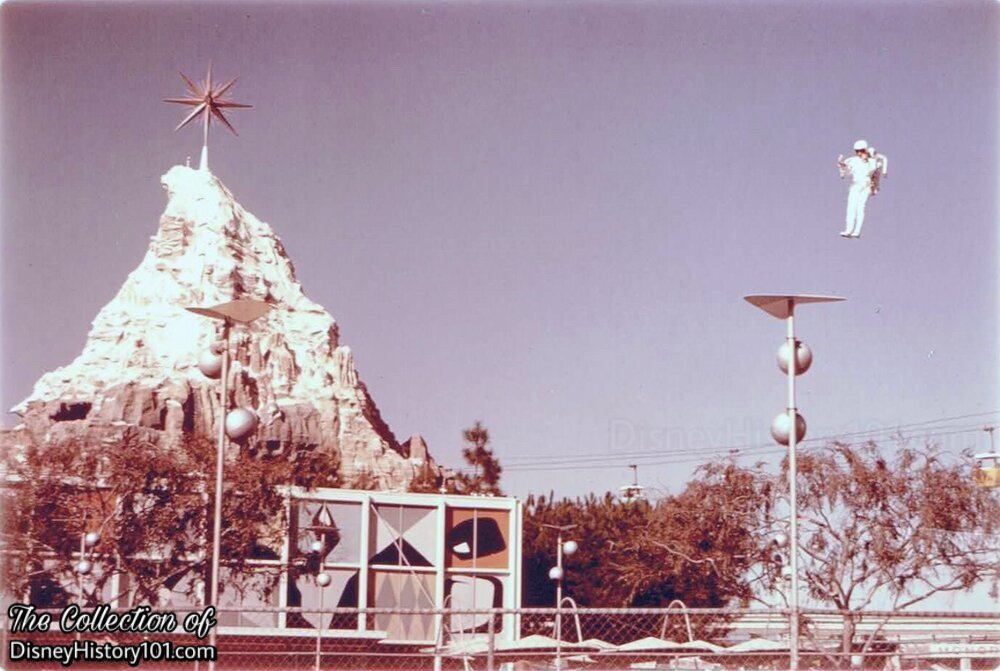
Bell System Rocket Belt Flight Test at Disneyland, 1965.
“ROCKET BELT PERFORMANCE STOPS MATTERHORN CLIMBER IN HIS TRACKS”
Finally, for a few weeks (from Saturday, December 18th, 1965 through January 2, 1966), the Bell Systems Rocket Belt Flight Test Pilots thrilled audiences at Disneyland! A local area article (published December 21, 1965) commented: “An exhibition equally fantastic is the jet rocket men which preceded the parade Saturday night and will be seen daily in Disneyland’s Tomorrowland through January 2. Wearing Bell Aerosystem’s Rocket Belts, the men fly through the air with the greatest of ease, a sign of things to come.”
Later, you may have seen the Bell Aerosystem’s Rocket Belt in episodes of Lost in Space (aired 1965) and Ark II (aired 1976), and even United Artists’ Thunderball (released 1965). However, none of these small-screen or silver-screen appearances matched the thrill of seeing a man fly over Tomorrowland, and land in the Flight Circle! Testifying to this is John Jay Pelletier who was climbing the Matterhorn at that moment. John remembers :
“We didn’t know what was going on. We saw a lot of cameras on ‘three-wheelers’ and tripods all around. It was just like when Julie Andrews visited the park. We looked around and there was a whole caravan of cameras, and we saw a guy on a platform, and he just took off. He got off the ground about 50 feet, went over 100 feet, and he came up to a metal platform near Main Street. He came down slowly, but when he came down it was very loud - like a loud whistle (or some thing like that). The crowd was cheering and applauded, and it wasn’t until the next day that I was able to read about it in the paper. That was something…amazing!”
During the Summer of 1966, the Rocket Belt Team of Bell Aerosystems Co. sincerely wrote Wally Boag (then-Editor of Backstage Disneyland magazine) : “We received a copy of Backstage Disneyland Magazine from Bill Bealer. The Team was very happy to see and read about the people we met and worked with at Disneyland. During our stay there, everyone was very kind and cooperative, from the Shipping Department personnel to the top office. The team will always remember our stay there ; it ws one of the more pleasant places to fly. We are proud to be ex-employees of Disneyland,” [Backstage Disneyland “Letters to the Editor”, Summer of 1966].
By July 1st, 1967, plans to bring one more Bell Systems Rocket Belt Flight Demonstration to Disneyland, for the Dedication of Tomorrowland, were being arranged. The pilots (none other than Yaeger and Meikeljohn) met with Ben Harris (Disneyland Entertainment Department) for dinner at the Disneyland Hotel Gourmet Restaurant to discuss this possibility.
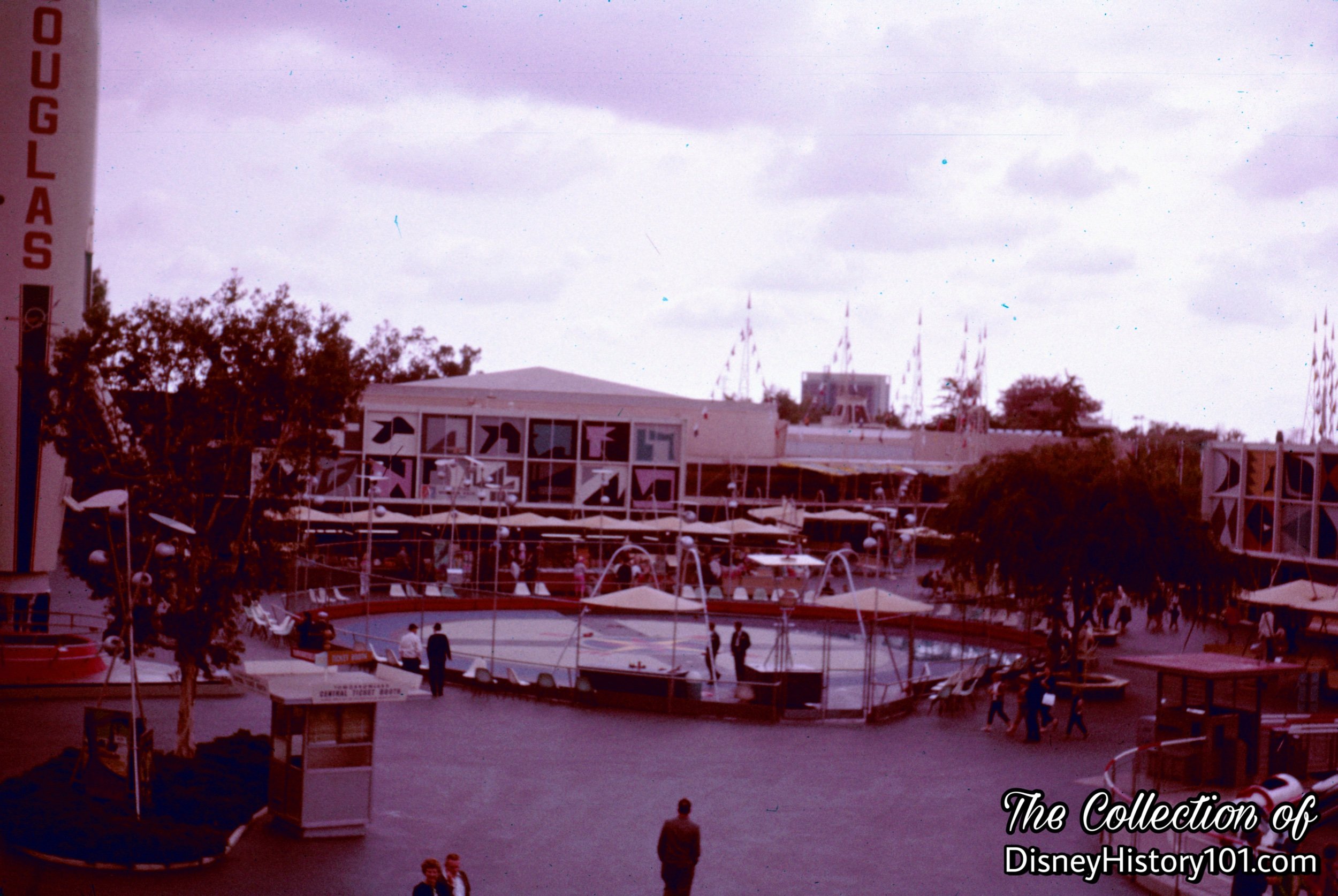
Thimble Drome Flight Circle in Tomorrowland
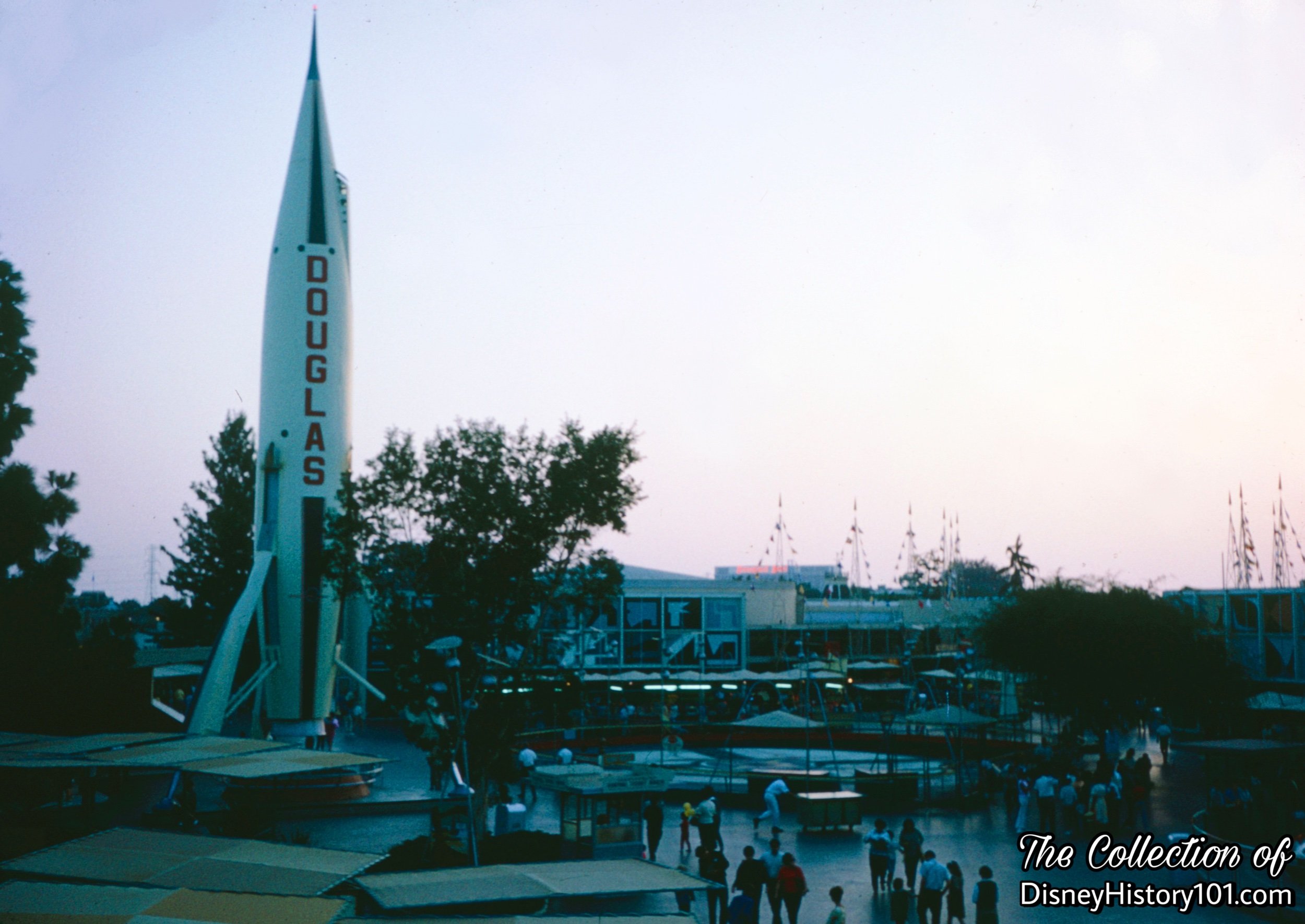
Thimble Drome Flight Circle in Tomorrowland
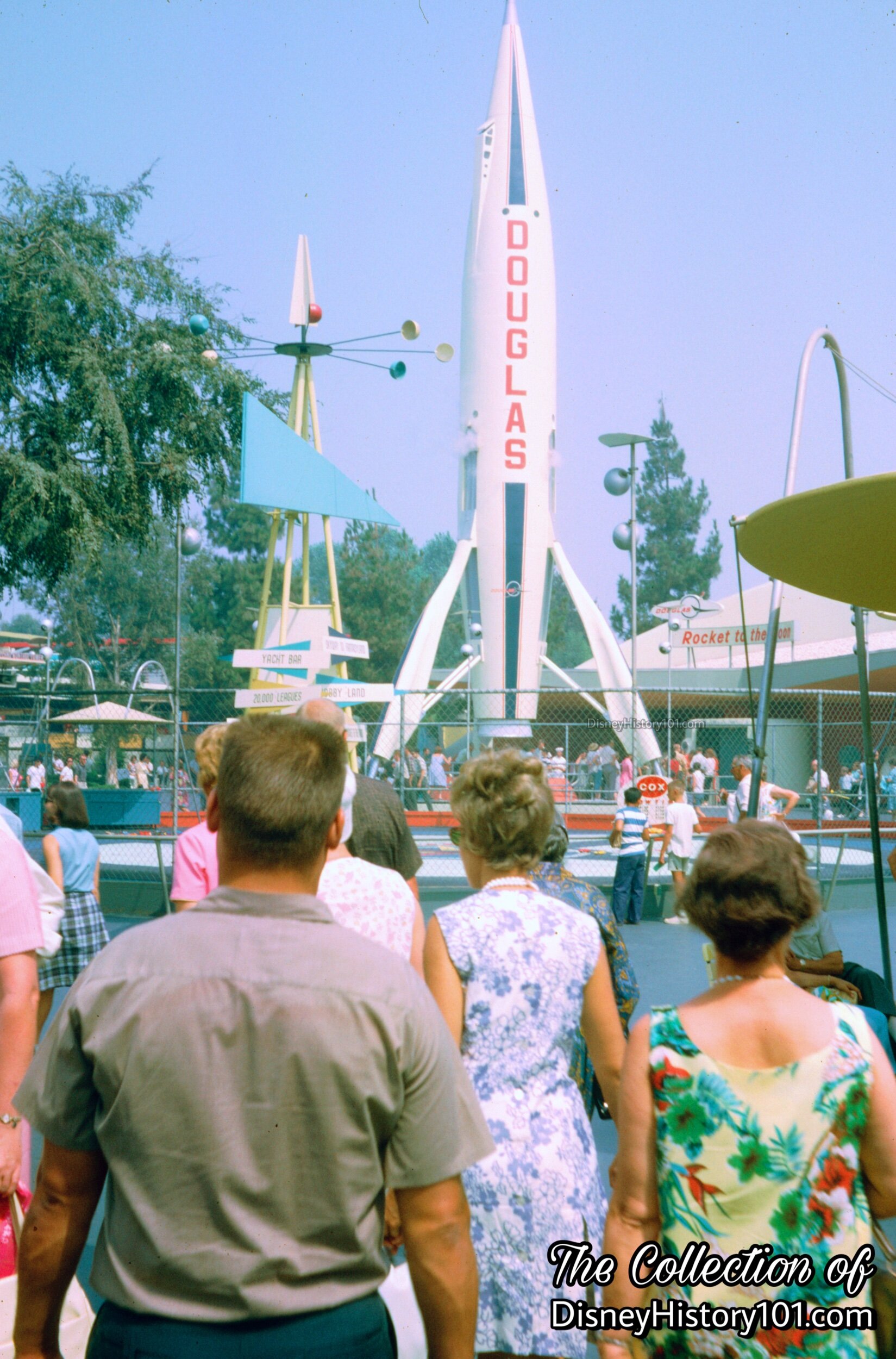
Thimble Drome Flight Circle and audience.
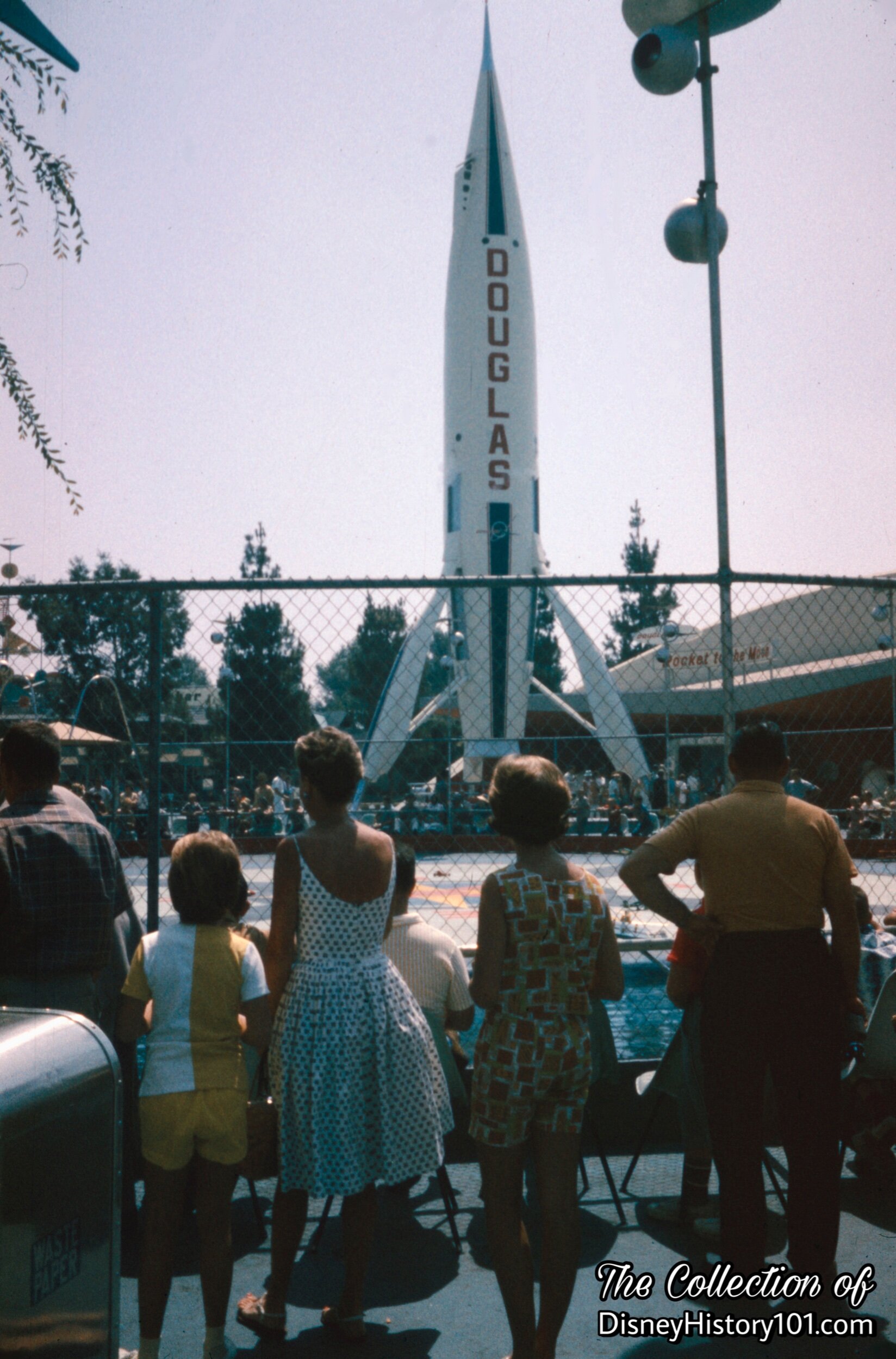
Thimble Drome Flight Circle audience.
The “Rocket Man” was one of the last major events to occur at the Flight Circle (happening during the winter season of 1965-1966).
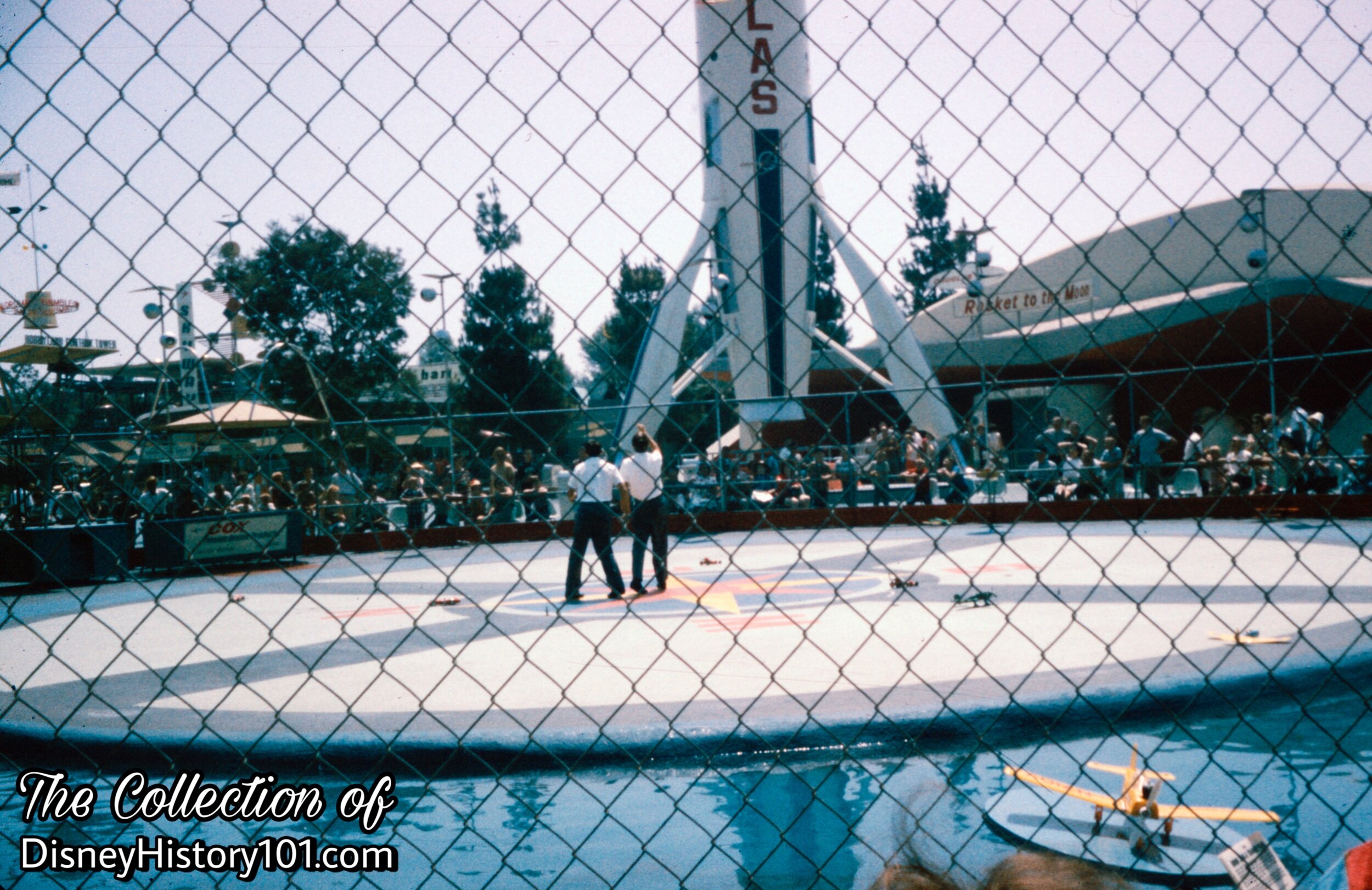
Thimble Drome Flight Circle Attractions Hosts and show through the perimeter fence.
As late as the summer of 1966, the Flight Circle was still creating tangible memories for Guests through Merchandise and Show. “The familiar burr of a WWI Sopwith Camel fighting with a Fokker or the whine of a high powered racing car” could still “be heard coming from the Hobbyland Flight Circle,” according to Backstage Disneyland writer Opal Henn (of the nearby Bell Systems exhibit), who welcomed the Cox Company back to Disneyland in print during the Summer of 1966. However, these sounds would soon disappear.
At a Walt Disney Productions Stockholders meeting (held on February 1, 1966), “Mr. Tatum pointed out - 50% of all visitors to Disneyland return later to see the Park’s new attractions.” Next, a need for an increased capacity was stressed, by “more facilities - rides, attractions, food and merchandising, to handle properly and efficiently our ever increasing guests.” And so, the Tomorrowland Flight Circle would yield to progress and make way for maximum utilization of space and an efficient, New Tomorrowland Show!
